Kingdom Comeback: The Chiefs’ Seven-Year Journey to a Super Bowl Title

Three thousand miles from Miami, in the Los Feliz section of Los Angeles where Andy Reid grew up, 50 or so of his childhood friends gathered on Sunday for a Super Bowl party. The day marked an equally somber and joyous occasion, and the living room showed both. On the mantle near the television the group had placed a wooden urn, similar in size to a football, with a gold-plated plaque. Atop the box of ashes, they placed a Kansas City Chiefs hat.
“Win the Super Bowl for Tony,” they told one another, hoping Reid could deliver for their late friend.
Across the country, the Chiefs coach paced back and forth during what most everyone else saw as a career-defining championship game, the only one he’d never won as a head coach. Now it was past the point of considering all that had led him to the sideline at Hard Rock Stadium. He couldn’t worry about everything he’d lost—not Super Bowl XXXIX and not the 14 playoff games; not the most painful loss of all, his son Garrett, who died of an accidental drug overdose in 2012. He couldn’t consider the move to Kansas City and the way that his history and the Chiefs’ history—always successful but always, ultimately, tortured—had intertwined.
His friends in L.A. knew this all, though, as they dined on ribs and cheeseburgers, two of Andy’s favorites. They knew who he was coaching for. They knew who wasn’t around to see it. And they knew—everybody knew—the one player who could deliver him to the place he’d never been, atop the NFL universe, Lombardi Trophy in his meaty hands. As the national anthem played and the fireworks exploded, they saw the game and they saw the urn and they all brought up the same name: Patrick.
* * *
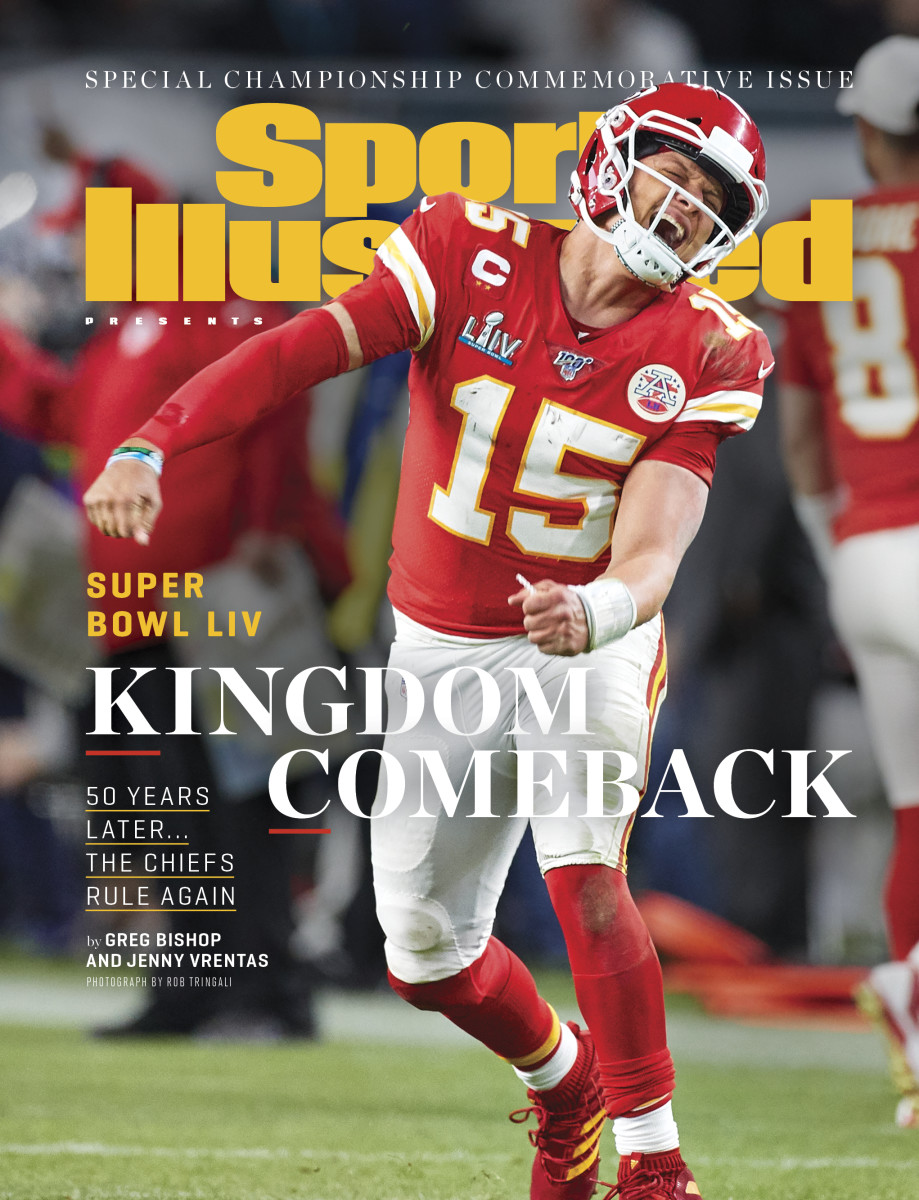
Five hours later, in Miami Gardens, Patrick Mahomes sauntered up to a lectern in a white tent across from Hard Rock Stadium. The clock ticked toward 11 p.m. He was still wearing his shoulder pads, his playbook wristband and his white uniform pants, grass-stained down the right flank from the four sacks he took or from one of the nine plays on which he scampered to extend drives.
Here was the 24-year-old who’d seized the MVP honor in the final 7:13 of Super Bowl LIV. Mahomes had turned stunning comebacks into routine affairs all January, erasing double-digit deficits against the Texans in the divisional round and against the Titans in the AFC championship. But neither of those teams had bottled and bludgeoned him like the 49ers had. With more than half of the final quarter elapsed—having ended consecutive drives with interceptions, staring at a 10-point deficit—Mahomes faced both a third-and-15 from his own 35 and an angsty fan base that was wondering whether his late-game magic had finally worn off.
The Chiefs called a play they’d deployed last season, against the Patriots in the playoffs. For most of Sunday, Mahomes would explain later, the 49ers’ defense had been playing a robber coverage, where the safety came down to “rob” K.C.’s deep crossing routes. On this down, Chiefs tight end Travis Kelce stutter-stepped before crossing the field. Meanwhile, Tyreek Hill ran what they call a Detroit route: Lined up in the slot, he faked a post and, when he hit the hash mark, cut back outside. As he turned back out toward the corner, San Francisco’s DBs lost track of him. Pass rushers clobbered Mahomes on that play, but he managed to heave a 44-yard pass, the high-arcing throw allowing Hill plenty of time to settle under it at the 49ers’ 21. The pass changed everything.
The Chiefs would score three touchdowns in the next six minutes. On the last one, running back Damien Williams looked for a first down, only to find open space, bounding up the left sideline and into the end zone. The scoreboard read 31-20. Mahomes had pulled off his fifth double-digit comeback this season, and his third in the playoffs, an NFL first.
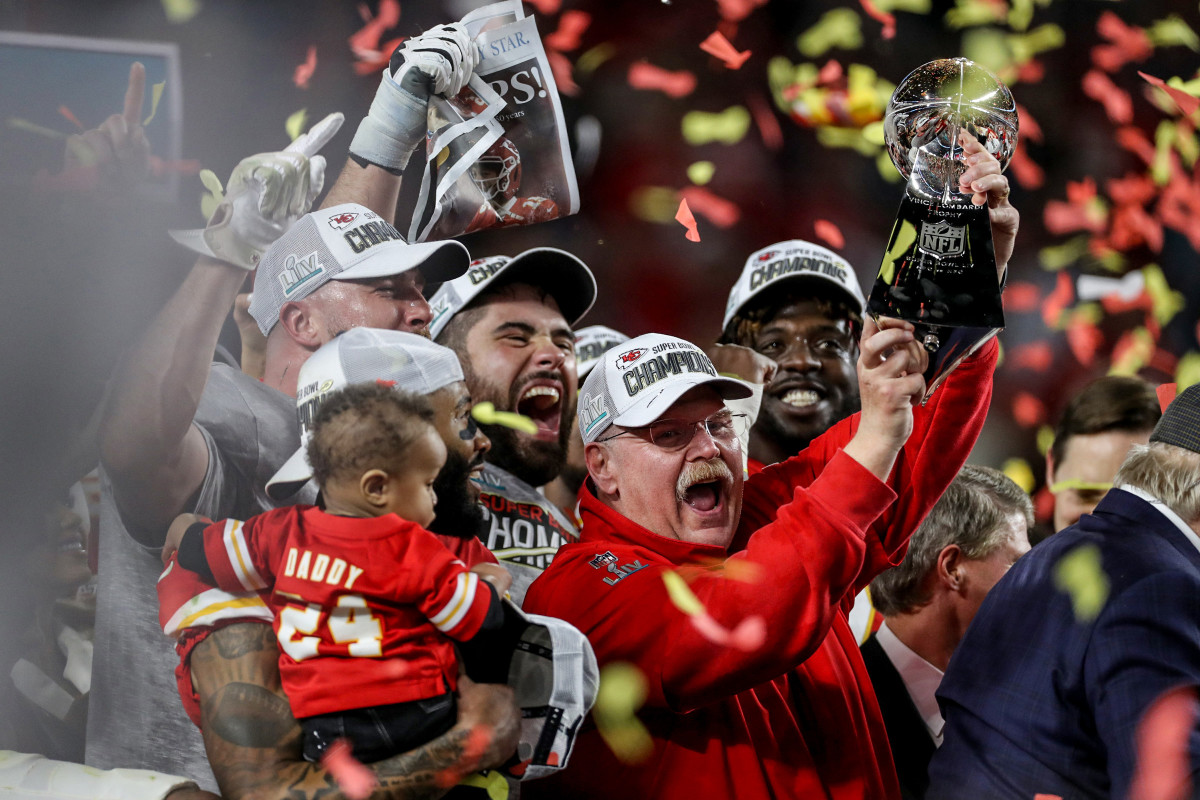
Chaos ensued, with Reid at the center: the orange-Gatorade bath; the long embrace with his quarterback; his son Britt, a Chiefs linebackers coach, fishing Andy’s fallen hat off the confetti-coated grass and returning it to his father’s head.
Back at the press conference, Mahomes focused on what the title signified for his coach, the guy who arrives at 3 a.m. and doesn’t leave until 11 that night. “I don’t think he sleeps,” Mahomes said as his mom, Randi, nodded along behind him.
It all felt a bit like a movie-cliché press conference, with reporters screaming questions at Mahomes, cameras flashing all around him. Meanwhile, his younger sister, Mia, leaned on the railing and yawned; her brother had long ago made the impossible seem routine. On the dais, Patrick said he’d set two goals when he became the Chiefs’ starter: Bring the Lamar Hunt trophy, named after his team’s founder, back to Kansas City; and win Andy Reid his first Super Bowl. The QB had accomplished both, but he pointed the credit back toward his beloved coach.
“He’s one of the best of all time,” Mahomes said.
* * *
On the first day of December in 2012—before Reid came to Kansas City, back when Mahomes was still in high school—Chiefs general manager Scott Pioli was pulling into his team’s facility for a staff Bible study when he noticed a Bentley parked awkwardly in the fire lane near the entrance. One of his players, a 25-year-old linebacker named Jovan Belcher, was exiting the car. He was crying and holding onto a gun.
As Pioli approached, Belcher screamed about how he’d just killed “her”—his girlfriend, Kasandra Perkins, the mother of their infant daughter. He’d come to thank Pioli and then to kill himself. Eventually he cocked the gun and, as police sirens sounded in the distance, dropped to his knees and shot himself in the head.
“An unimaginable event,” Pioli says. “No one can be prepared to understand that, to navigate through it, around it, over it.”
The Chiefs played the next day, registering only their second win in a season so miserable that fans had resorted to wearing paper bags over their heads. Change was imminent, but owner Clark Hunt had more to consider than just football. “I was looking for experience, maturity [in a coach],” he says, “and coming off the Belcher tragedy we needed someone who could build relationships in the building.” The best coach available that offseason happened to possess all these traits.
A month later, a K.C. contingent met with Reid at a private airport near Philadelphia for a nine-hour marathon interview. Pioli (who would leave the organization soon after) says they knew right away they’d found the one coach who made sense at a time when nothing else did. “For the healing and recovery that had to happen for the team and the franchise and the city,” he says, “Andy was the only person for the job.”
First Hunt had to make sure Reid could handle his own emotional unrest. After 14 years in Philadelphia, Reid’s closest friends were urging him to take a year off. Five months earlier, Garrett Reid—Little Red to Andy’s Big Red—had died at age 29, during training camp, where he was an assistant. “[Addiction] is a disease, and it's a tough thing to overcome,” Reid says now. “It doesn't matter what religion, what race; doesn't matter how much money you make. Sometimes it doesn't work.”
Reid buried his son, then poured himself back into film analysis, and when Philadelphia fired him after that 4-12 season, he met with the Chiefs two days later. Hunt began the interview alone with Reid, in a conference room with the blinds closed. He needed to know whether the coach was ready, and the coach said yes. Looking back, Britt says that “taking a year off and sitting around thinking about something tragic” wouldn’t have done his father any good.
“I think he feared the emptiness of that,” says Joe Banner, the Eagles’ former president and a longtime Reid confidant.
Midway through that interview, Reid’s agent sent home the Cardinals’ team plane, which was waiting on the tarmac, queued up for a meeting. There started the path to Reid’s first championship as a head coach. “It probably was a good healing process for me and for the Chiefs,” he says. “They had gone through some things. I went through some things. It was a good match.”
* * *
The son of a Hollywood set designer, Reid channels his artistic creativity through intricate play designs in legendary white-board sessions. In one such conference earlier this season he added a fifth receiver to an established pattern and came up with an easy-to-remember code name for the wild play: Dr. Octopus, a nod to Spider-Man’s multi-appendaged nemesis.
The Chiefs dialed up this call once this season, for a modest gain, but that’s not why Reid brought up the play in the weeks leading up to Super Bowl LIV. He was talking about how the process of moving forward in Kansas City would add meaning to every game. “Dr. Octopus, he’s got all those legs,” Reid said, motioning with his fingers. “I was thinking of how many things were involved in that year. Losing my son. . . the things that happened here. … Yeah, there are a lot of legs to this.”
After Reid arrived, the Chiefs built their Super Bowl roster in usual ways (through the draft and free-agency) and in unusual, riskier ones, adding players with serious issues, sometimes with criminal backgrounds. Past and present colleagues remain careful when discussing Reid’s approach to the matter; they don’t want to excuse any abhorrent behavior, but they say Reid believes in second chances, that he thinks he can help.
Take Hill, who made that momentum-shifting 44-yard catch and who last spring was the subject of a child-abuse investigation involving his young son. (A district attorney declined to press charges against Hill or the boy’s mother, even though he stated, “We believe a crime has occurred.” Hill denied any wrongdoing.) He was also recorded in March telling the mother of three of his children, “You need to be terrified of me b----.” Hill had already fallen to the Chiefs in the fifth round in the 2016 draft after pleading guilty to physically abusing the same woman while they were students at Oklahoma State.
While the Hill investigation was ongoing last spring, the Chiefs acquired pass rusher Frank Clark, who recorded a critical fourth-down, fourth-quarter sack of Jimmy Garoppolo in Miami, from the Seahawks. Clark was dismissed from the Michigan football team after being arrested on domestic violence charges against his girlfriend. (Those charges were reduced to fourth-degree persistent disorderly conduct.)
The Chiefs said they relied last summer on personal experience with Hill in deciding to keep him on their team and sign him to a contract extension. They leaned on their research—dating back to the 2015 draft and including conversations with members of the Seahawks’ front office—in trading for Clark and also signing him to an extension. Those additions seemed to suggest a pattern, that the coach would take chances on players where other teams might have passed, like when Reid signed free-agent Michael Vick in 2009, after the former Falcons QB went to prison for his role in a dog-fighting ring.
There’s no easy way to address these issues, but they remain part of the Chiefs’ story. It’s possible to distinguish between addiction and violent acts while acknowledging Reid’s empathy for human beings. It’s also possible to find those signings problematic, or related primarily to winning football games.
In Philadelphia, Reid cited the second chances given to his sons (Britt also struggled with addiction) as factors in the Vick signing. “It might have something to do with understanding people, if they really put their mind to it to change, maybe they can do that,” Reid says now. “Maybe they can put it out there and give it another picture, something better.”
Soon after Garrett’s death, Brett Veach, who had ascended from Reid’s assistant to an Eagles scouting gig, watched from his apartment as Reid coached his last game for Philadelphia, a road loss to the Giants. Afterward, Veach climbed in his car and drove to the facility to wait for the team buses. “I didn't want [Reid] to be in the office by himself,” he says. He texted: “Coach, I’m here for you. Just let me know.”
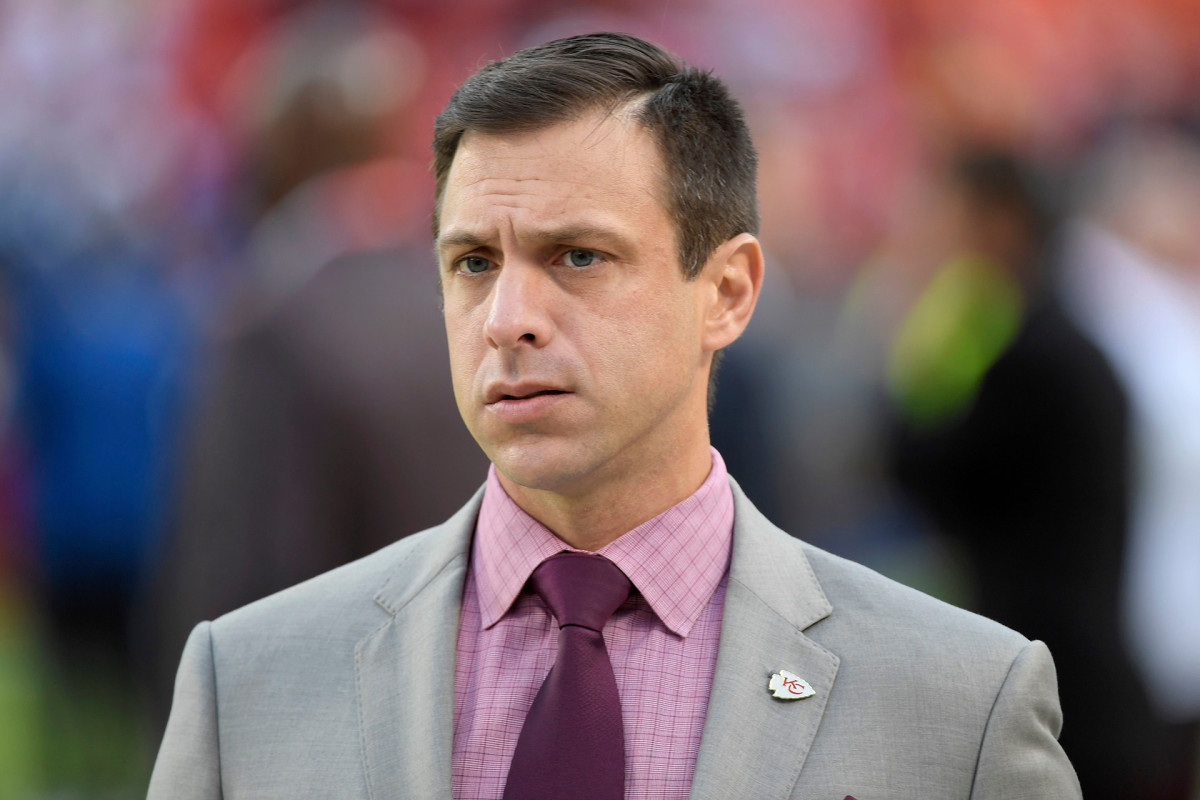
Eventually Reid summoned Veach to his office. The coach knew his run in Philly had ended, but here he was dissecting the game, lamenting missed opportunities and points left on the field. Finally he asked Veach for a favor: “There's some stuff … can you help me carry it out to my car?”
As the two trudged out into the cold December night, Veach told the man who brought him into the NFL, “Coach, I don't know what's going to happen in the coming weeks, but just know that wherever you go, if you want me around, I'll go.”
Said Reid, “I'm going to take you up on that.”
* * *
Veach went with Reid to Kansas City, helping assemble a playoff roster as he climbed the ranks to general manager, minus the piece they needed most. Then they found it the old-fashioned way, through intense film review.
From their bunker in the spring of 2016, Veach and the personnel staff under then-GM John Dorsey began to evaluate college quarterbacks, working from juniors to sophomores, where a certain Texas Tech passer’s highlights jumped off the screen. Reid stopped by one afternoon, asking Veach, “What are you up to?”
“Coach,” he replied, “I’m watching the quarterback of the Kansas City Chiefs a year from now.”
“Yeah, yeah, yeah,” Reid chuckled.
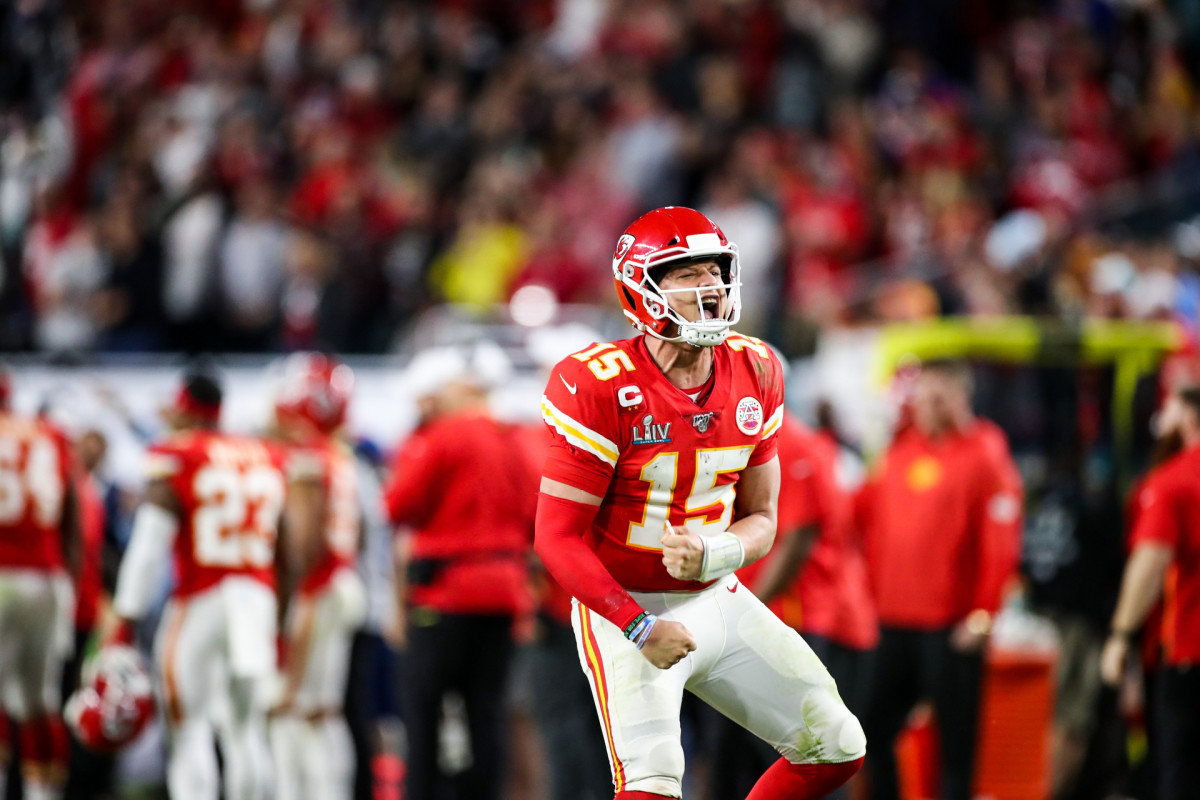
Patrick Mahomes and the Chiefs win Super Bowl LIV, the franchise's first Super Bowl in 50 years.
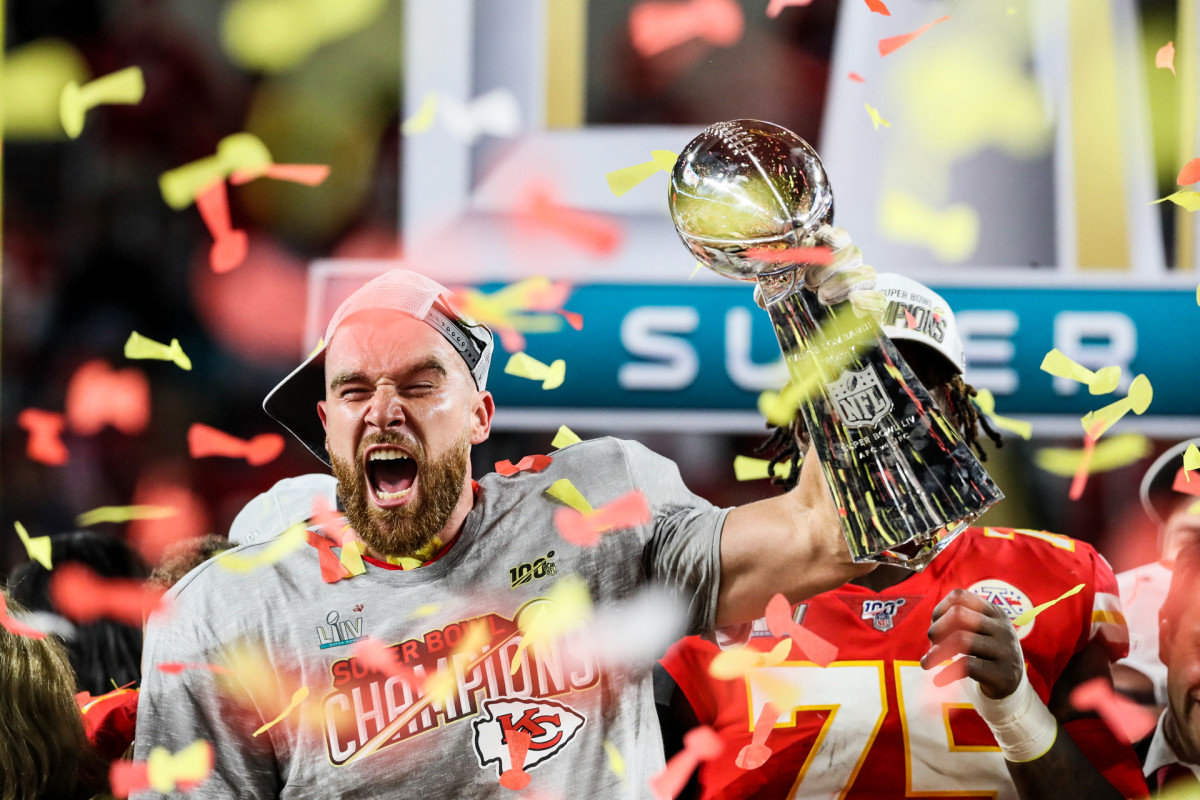
Travis Kelce.
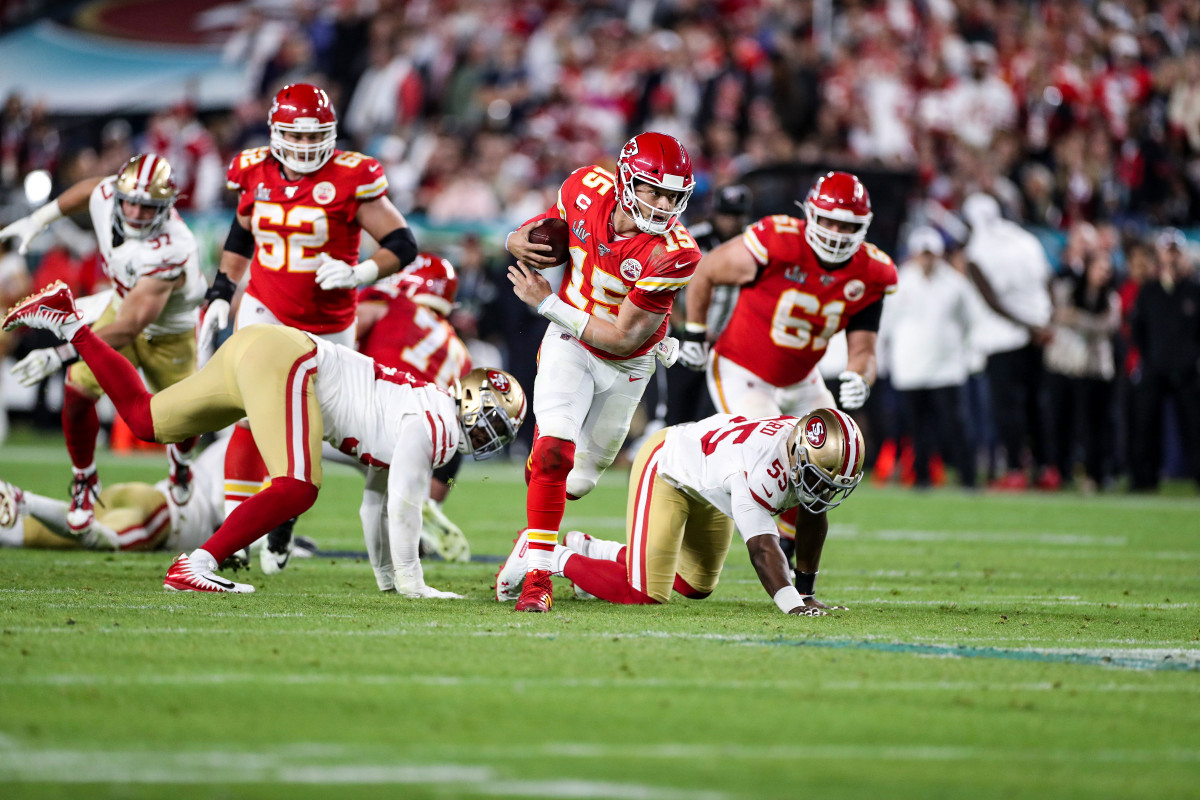
Patrick Mahomes
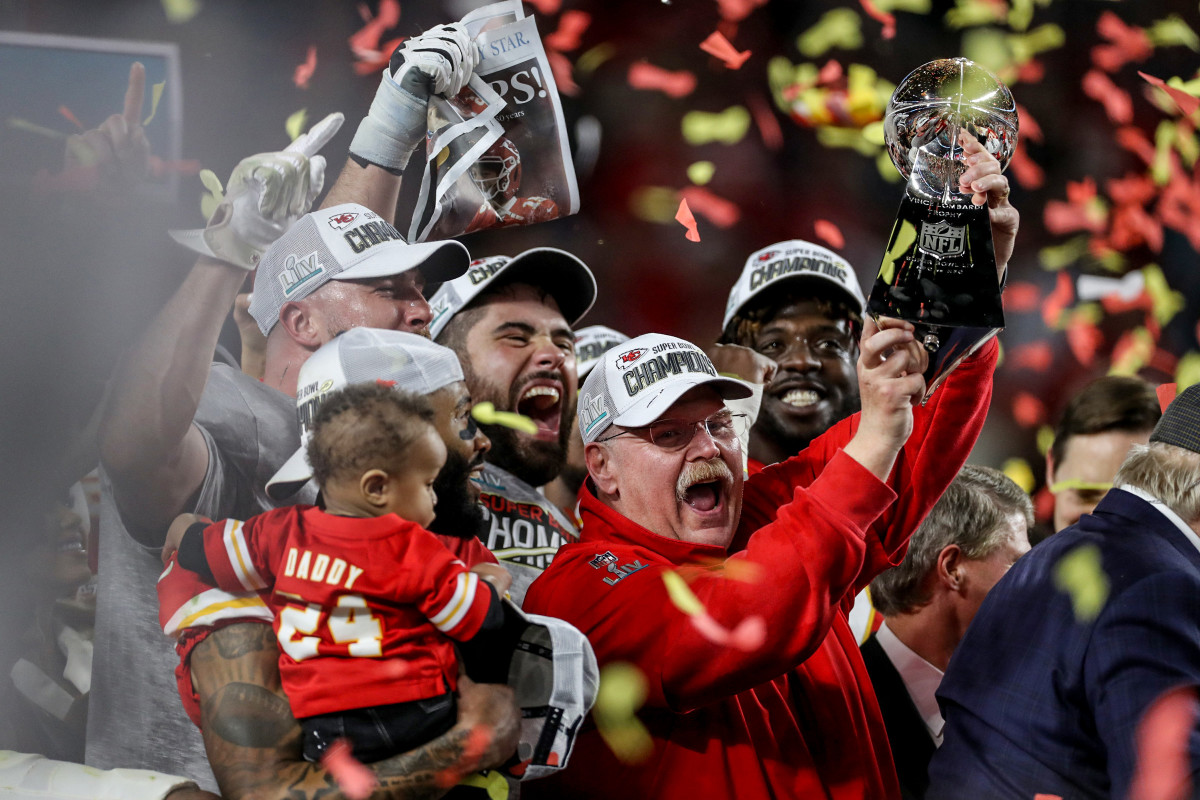
Andy Reid.
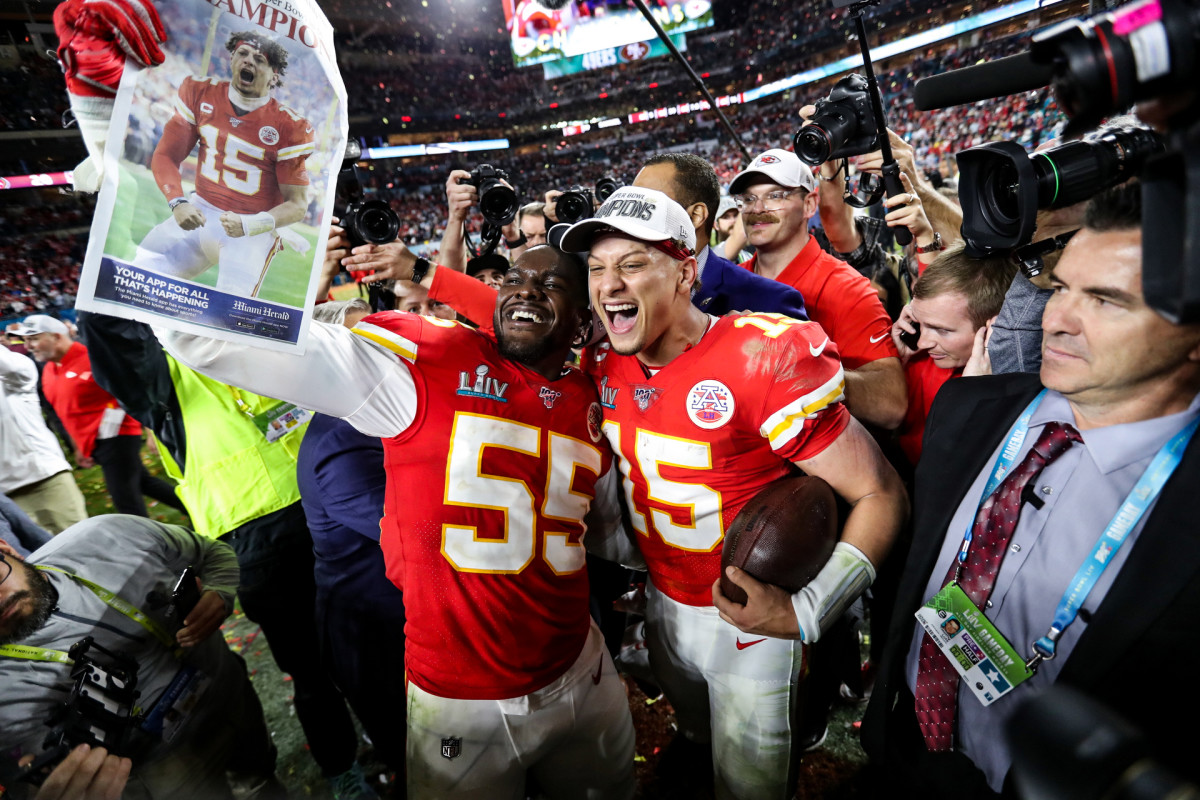
Frank Clark and Patrick Mahomes.
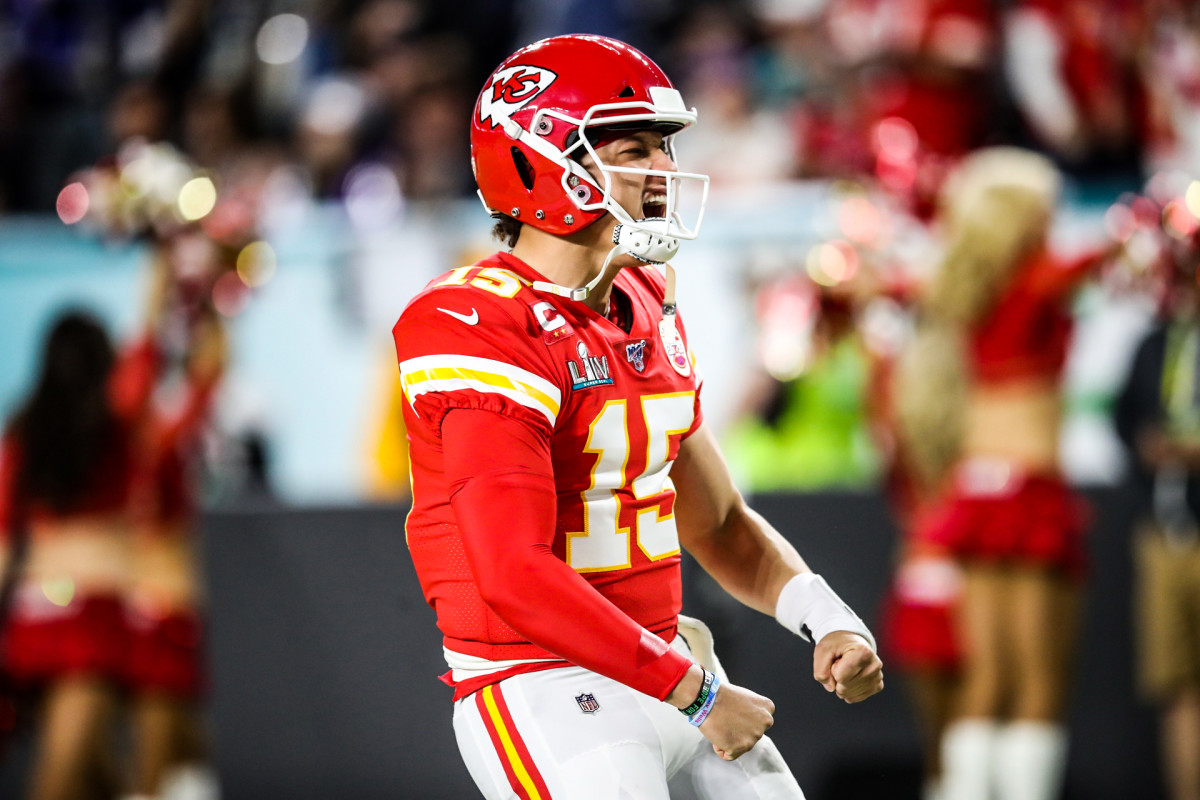
Patrick Mahomes
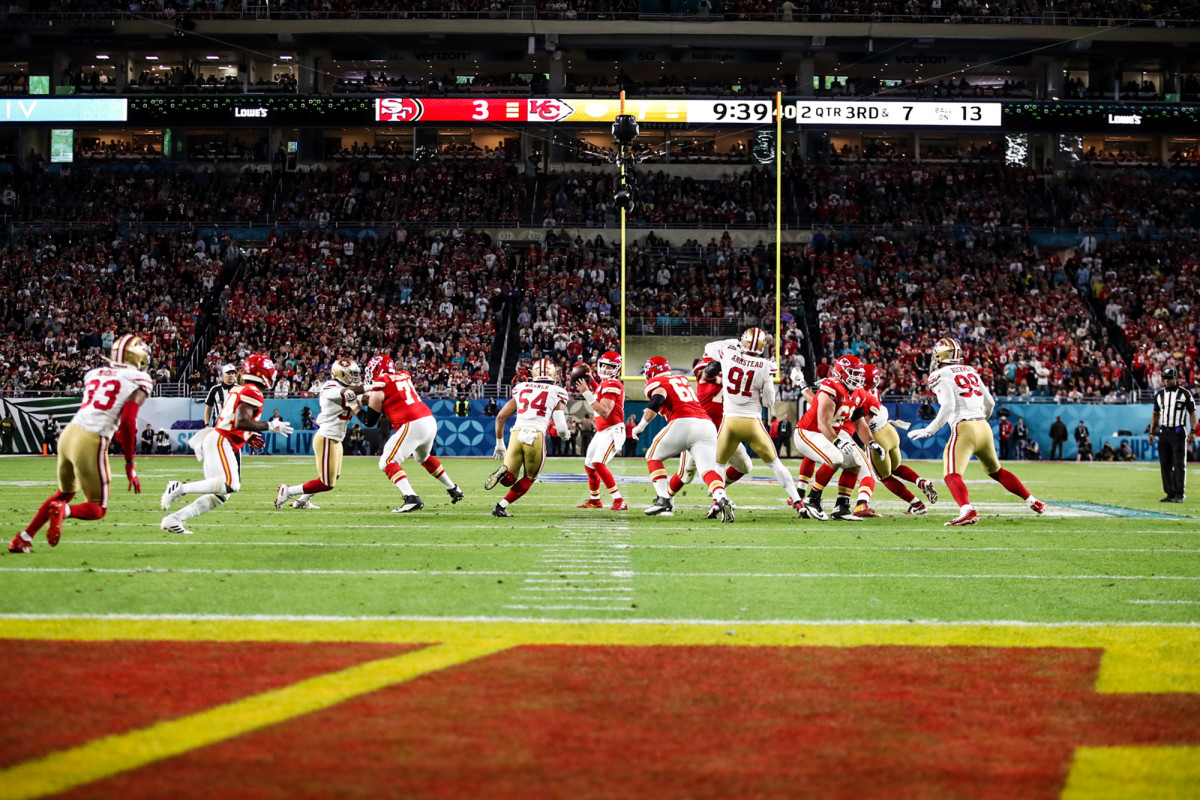
Patrick Mahomes.
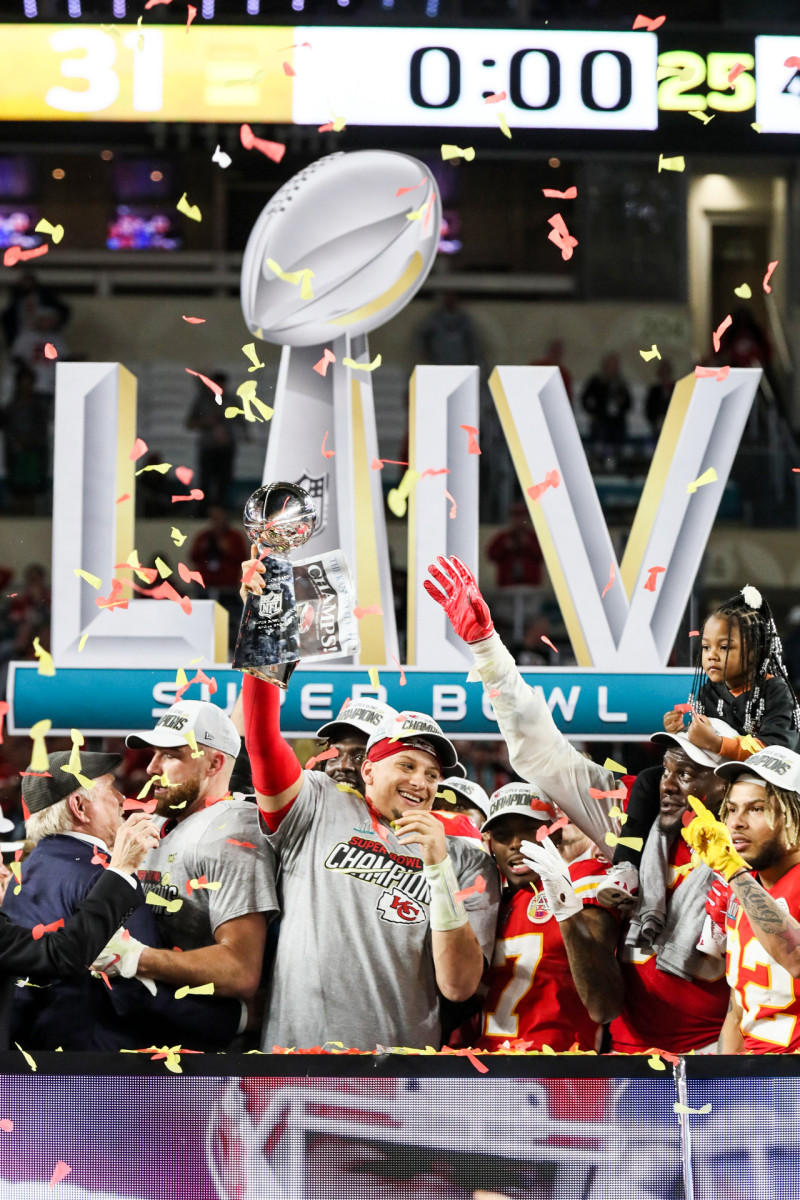
Patrick Mahomes.
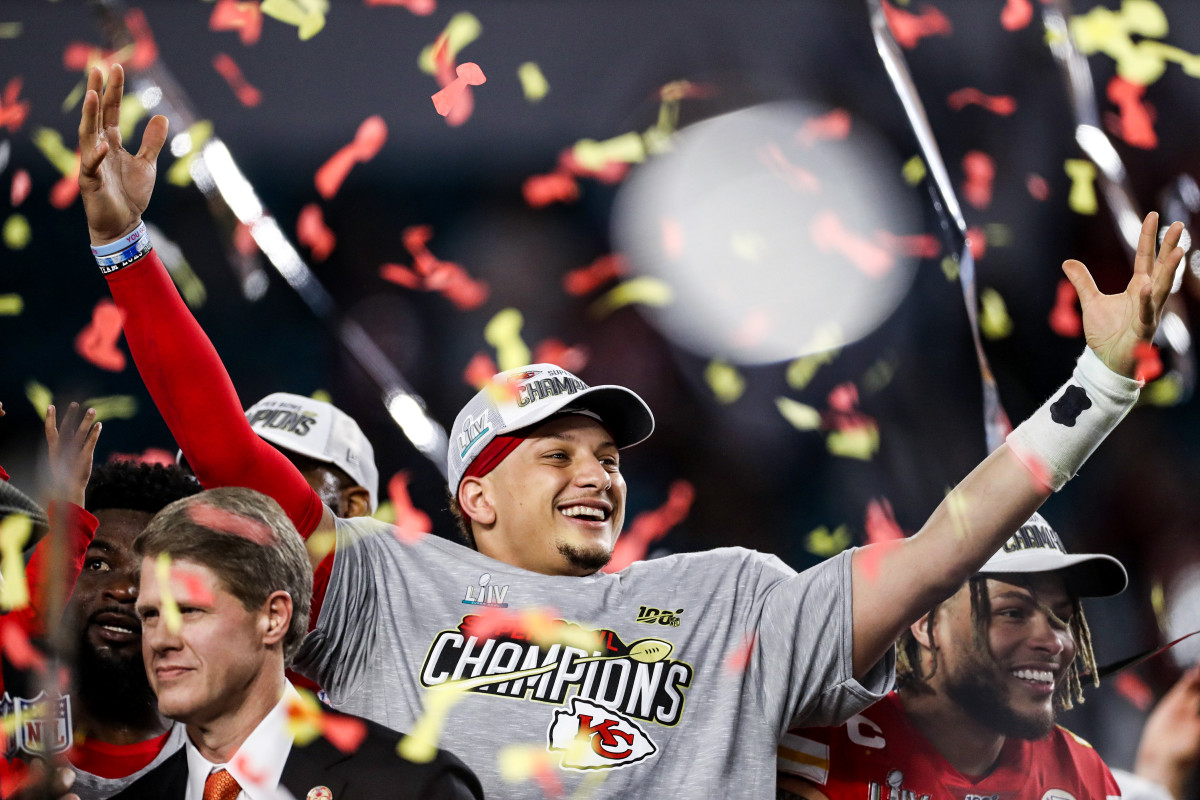
Patrick Mahomes.
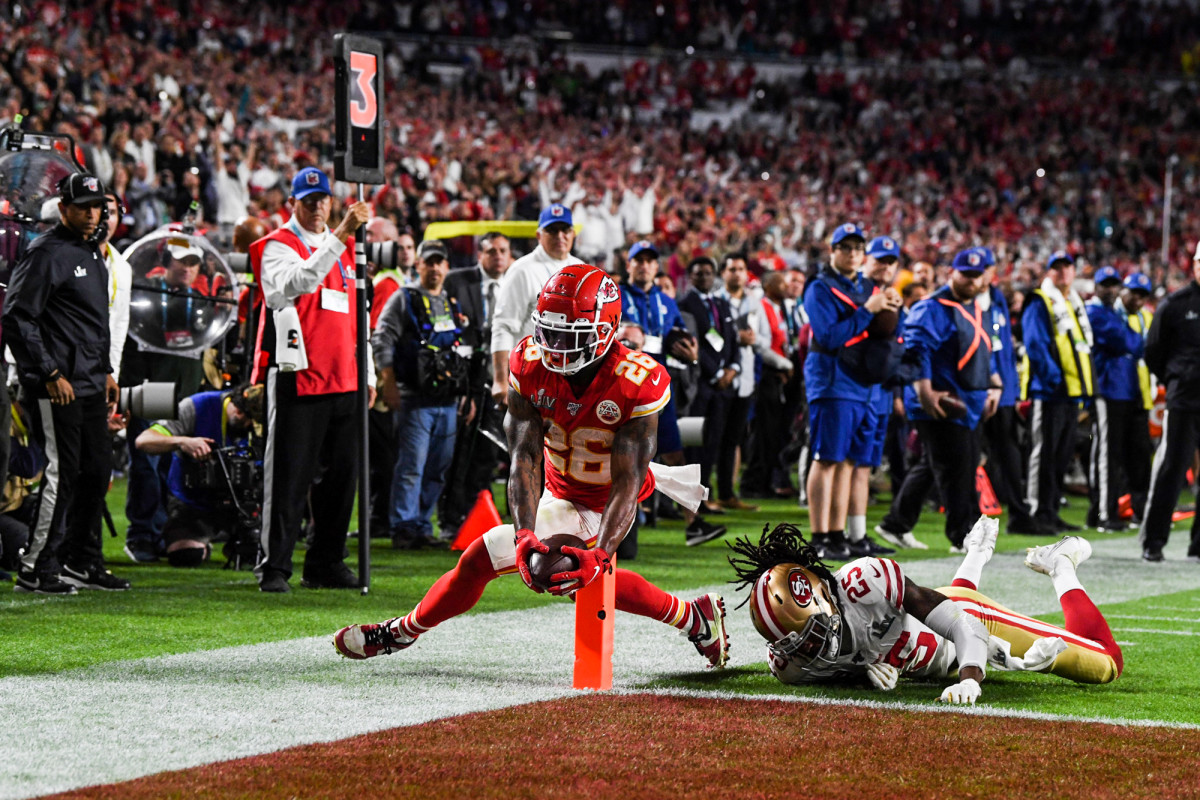
Damien Williams.
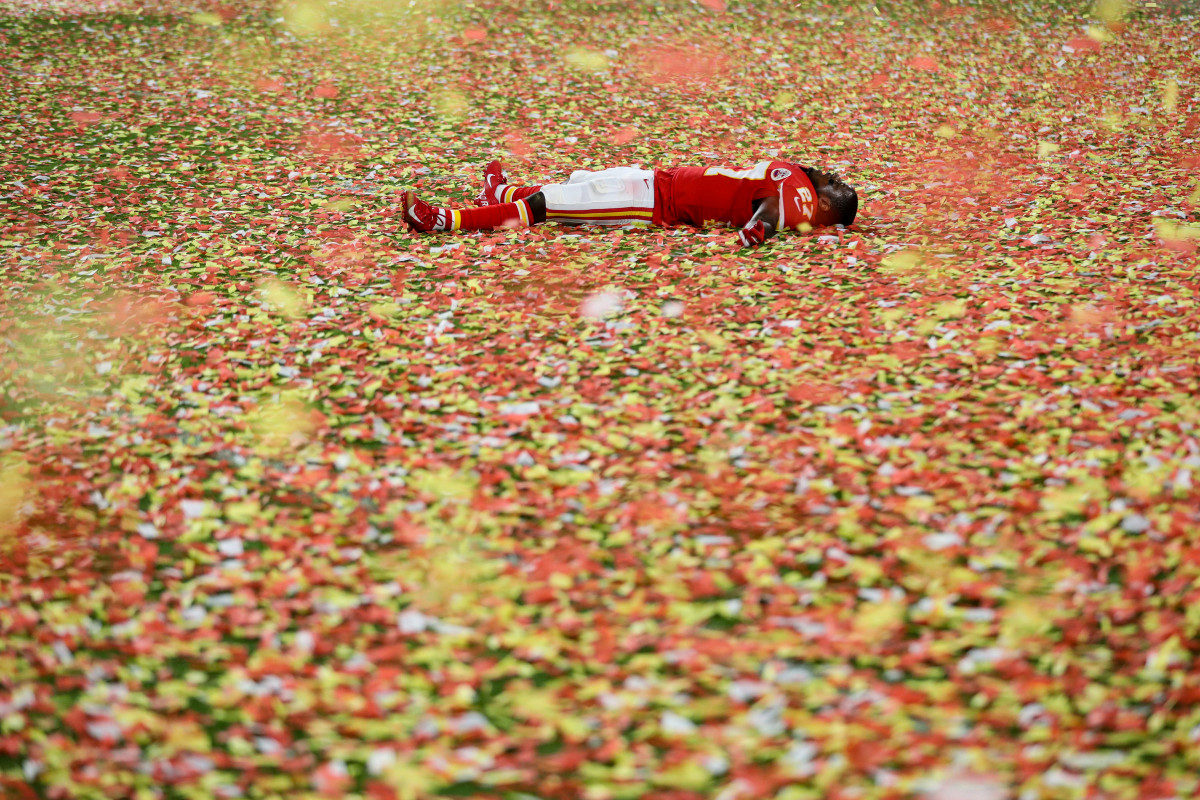
Rashad Fenton.
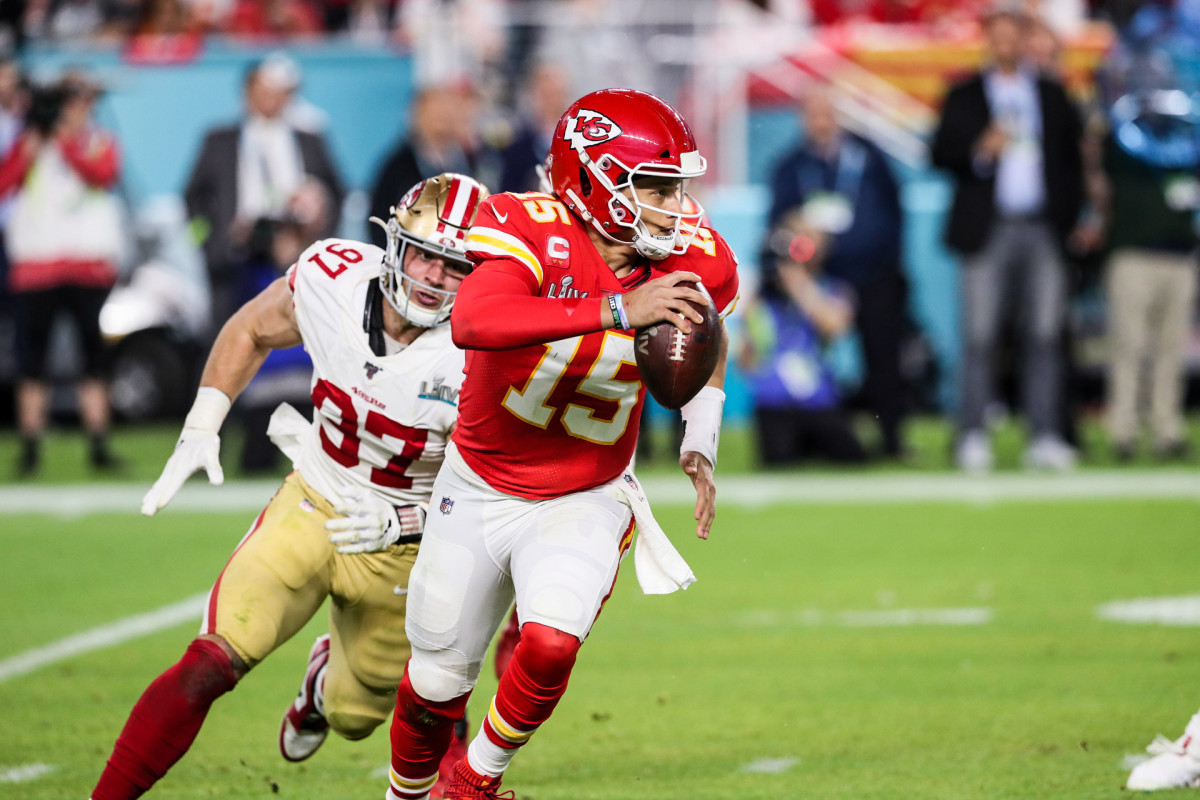
Patrick Mahomes.
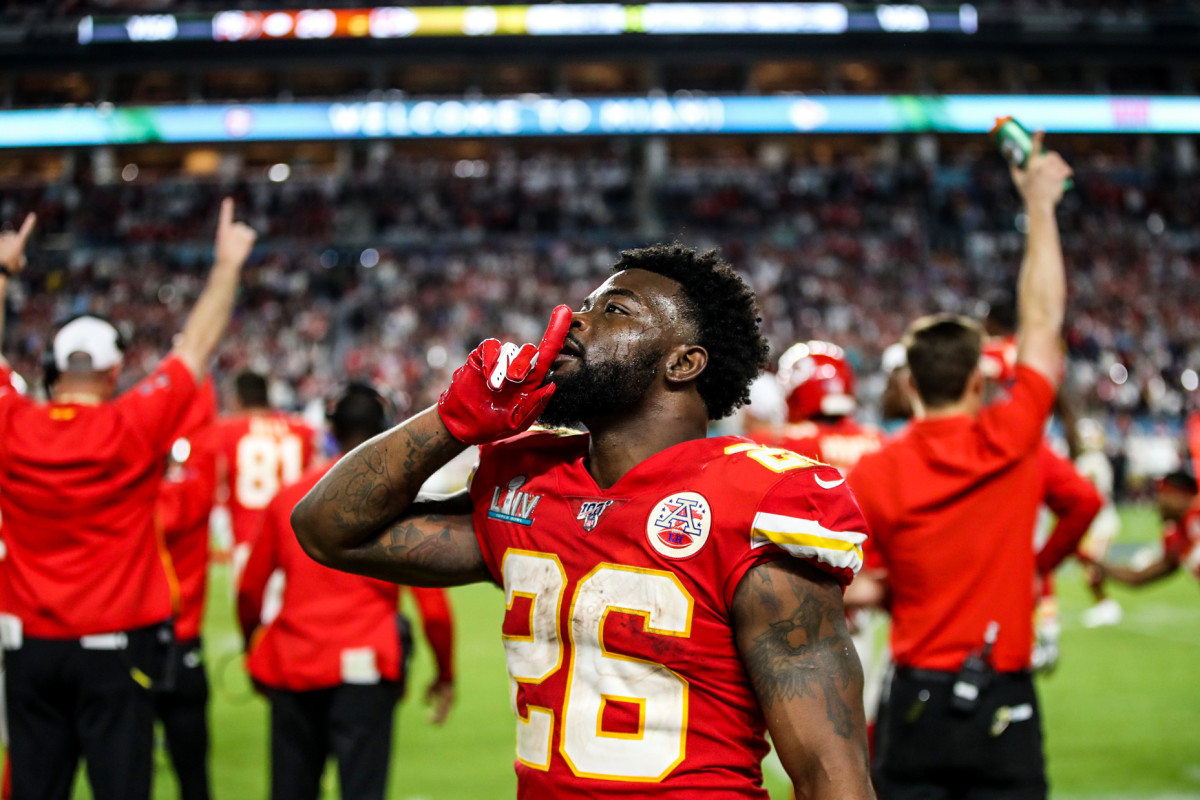
Damien Williams.
Patrick Mahomes
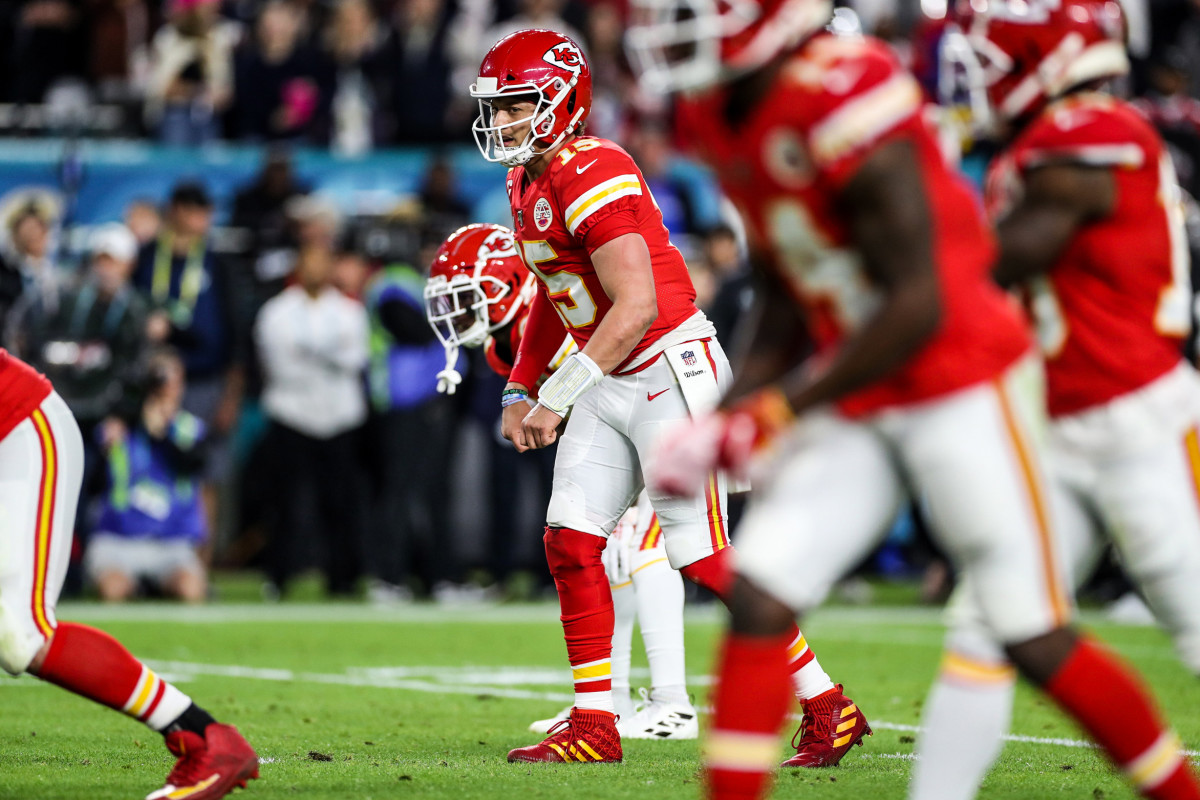
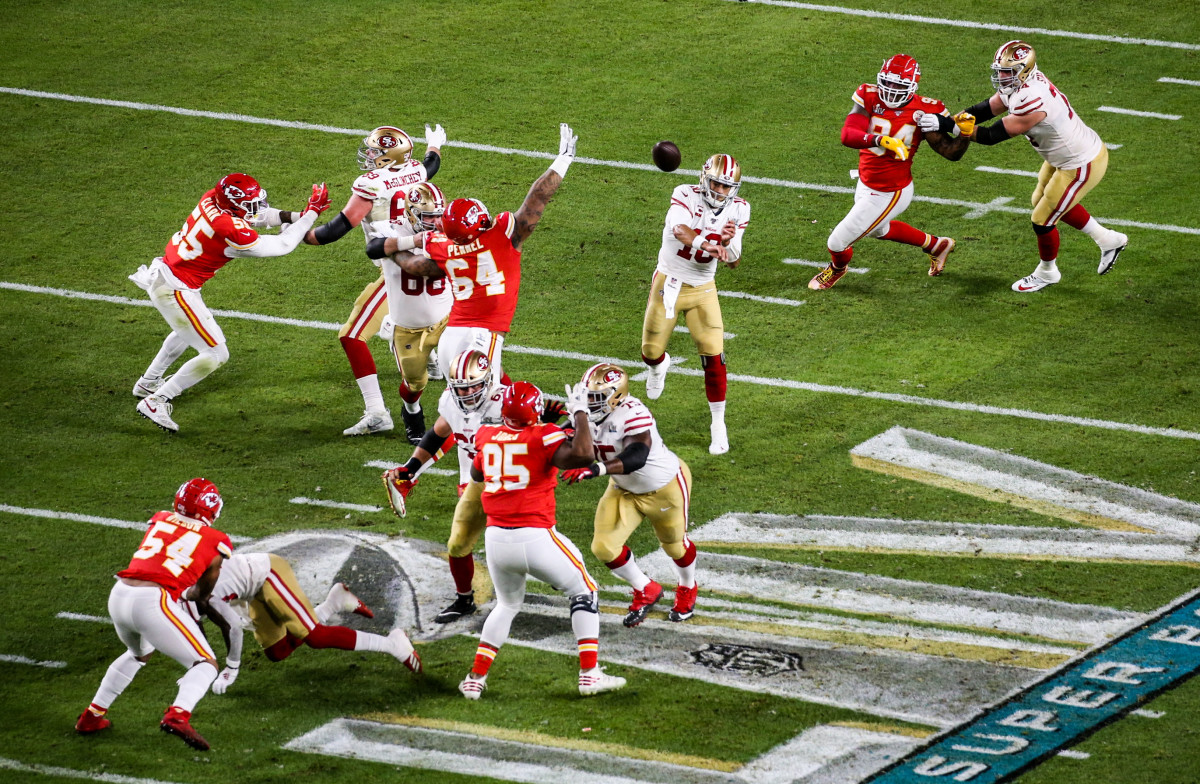
Jimmy Garoppolo in the first half.
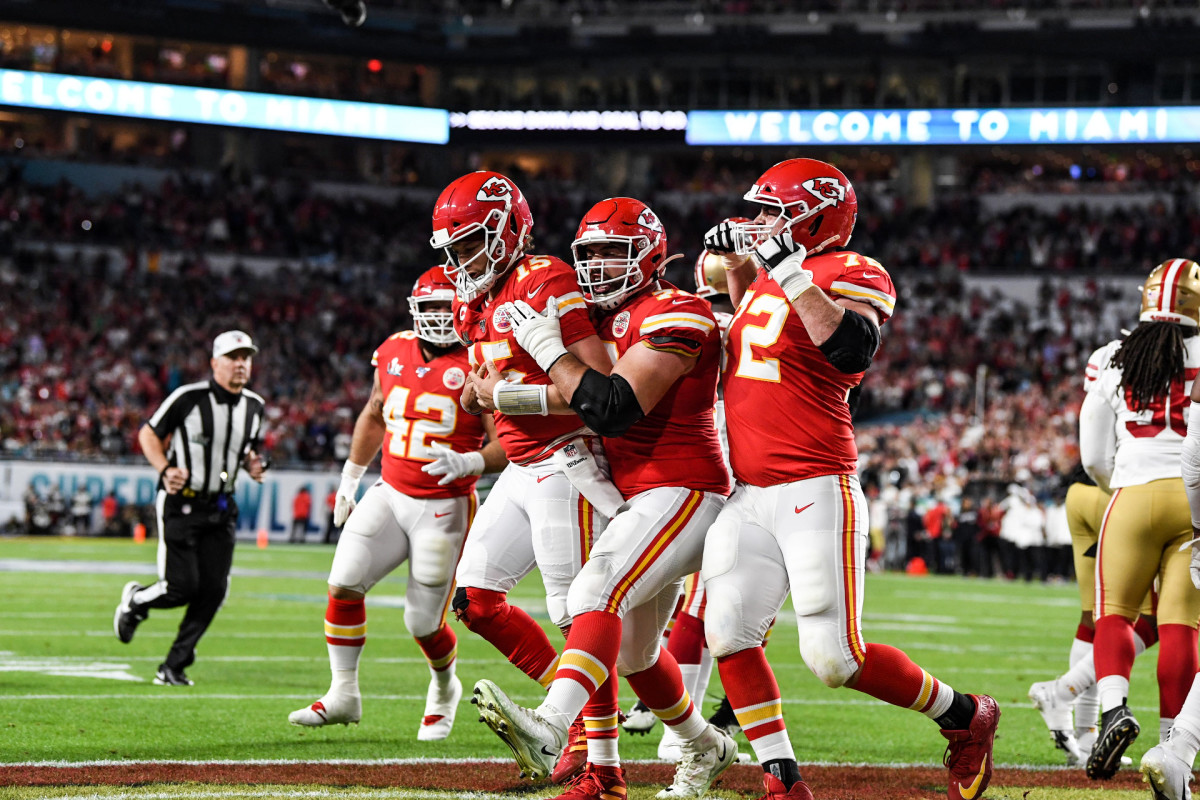
Patrick Mahomes celebrates a touchdown in the first half.
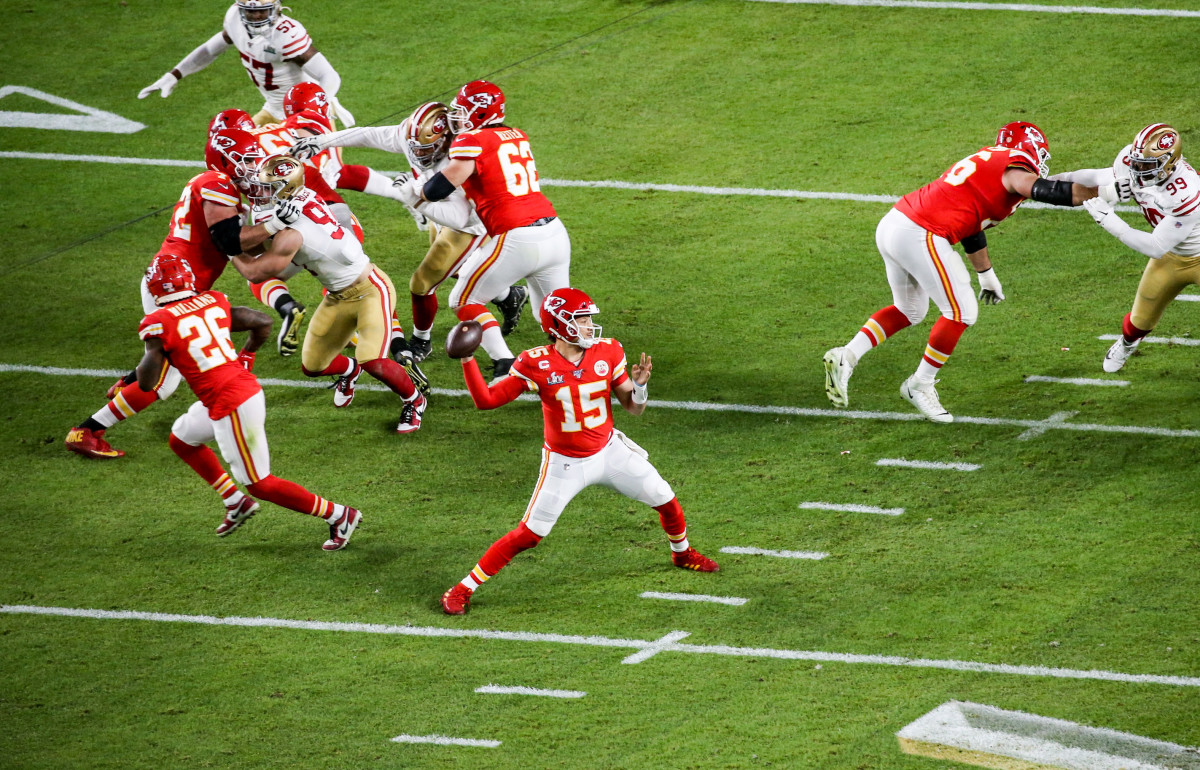
Patrick Mahomes in the first half.
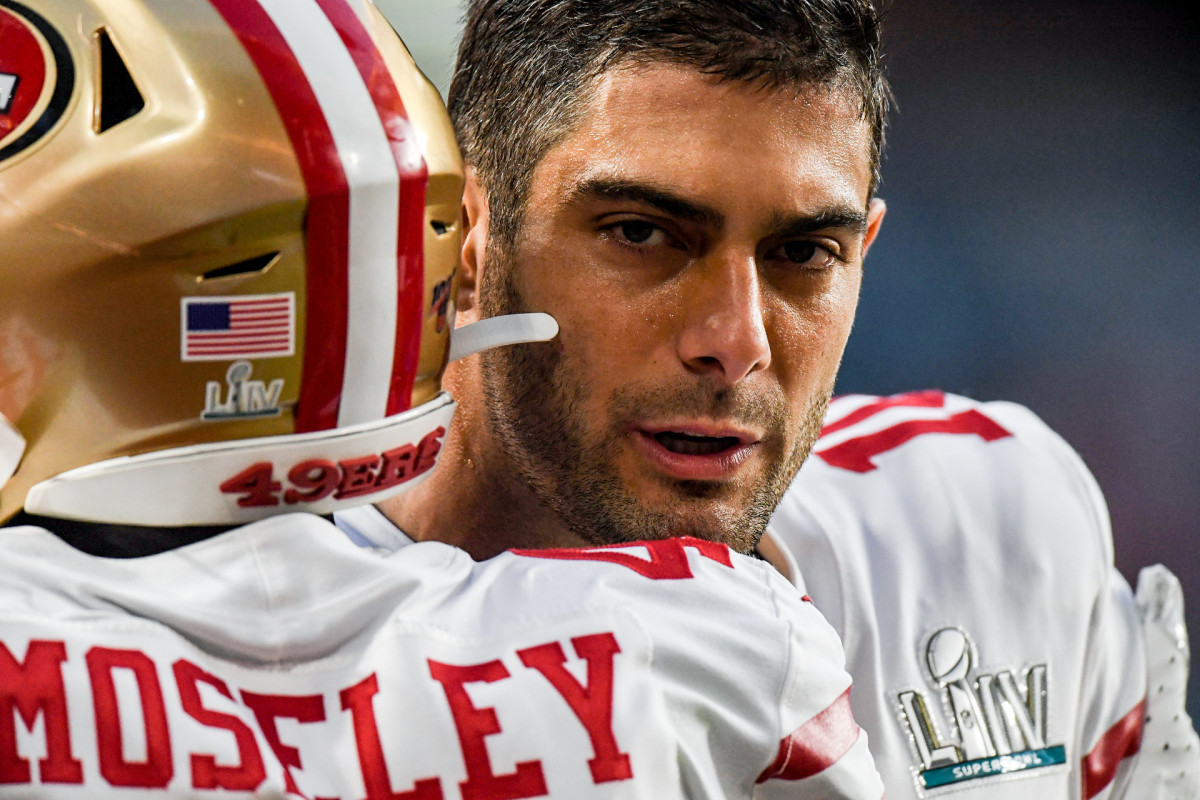
Jimmy Garoppolo in the first half.
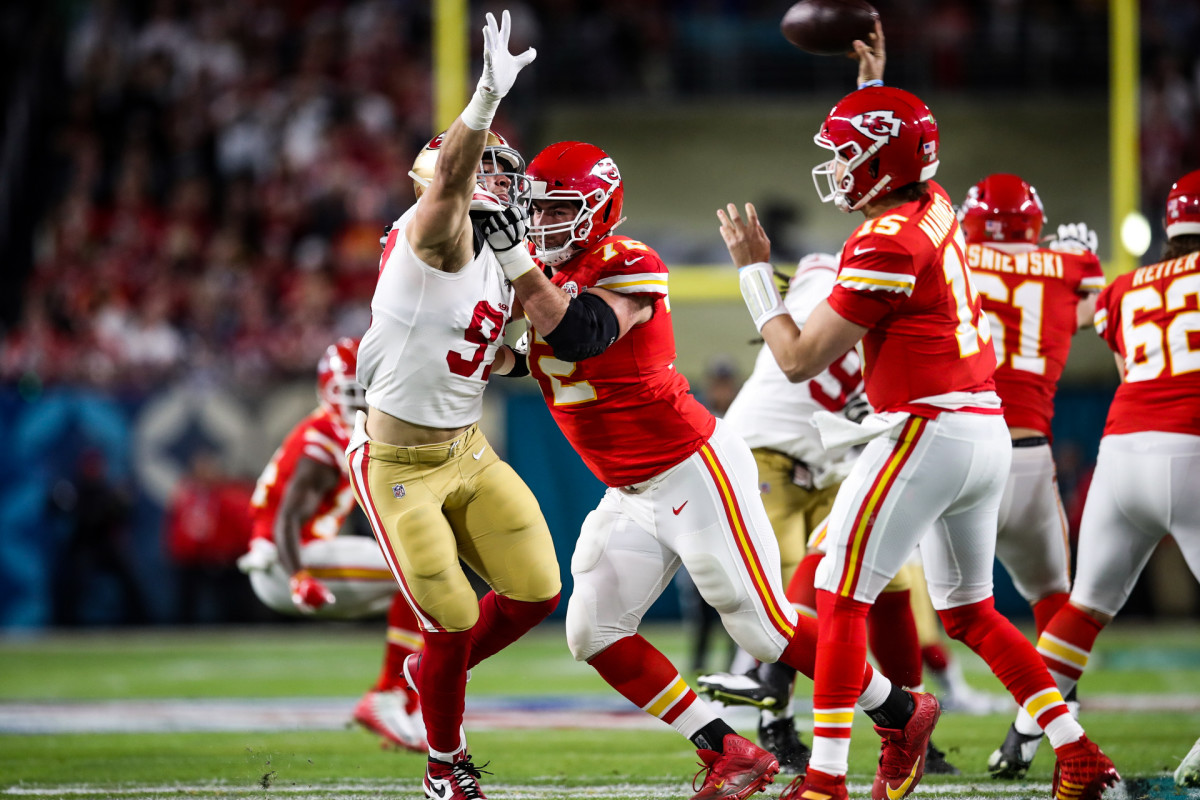
Kansas City defense.
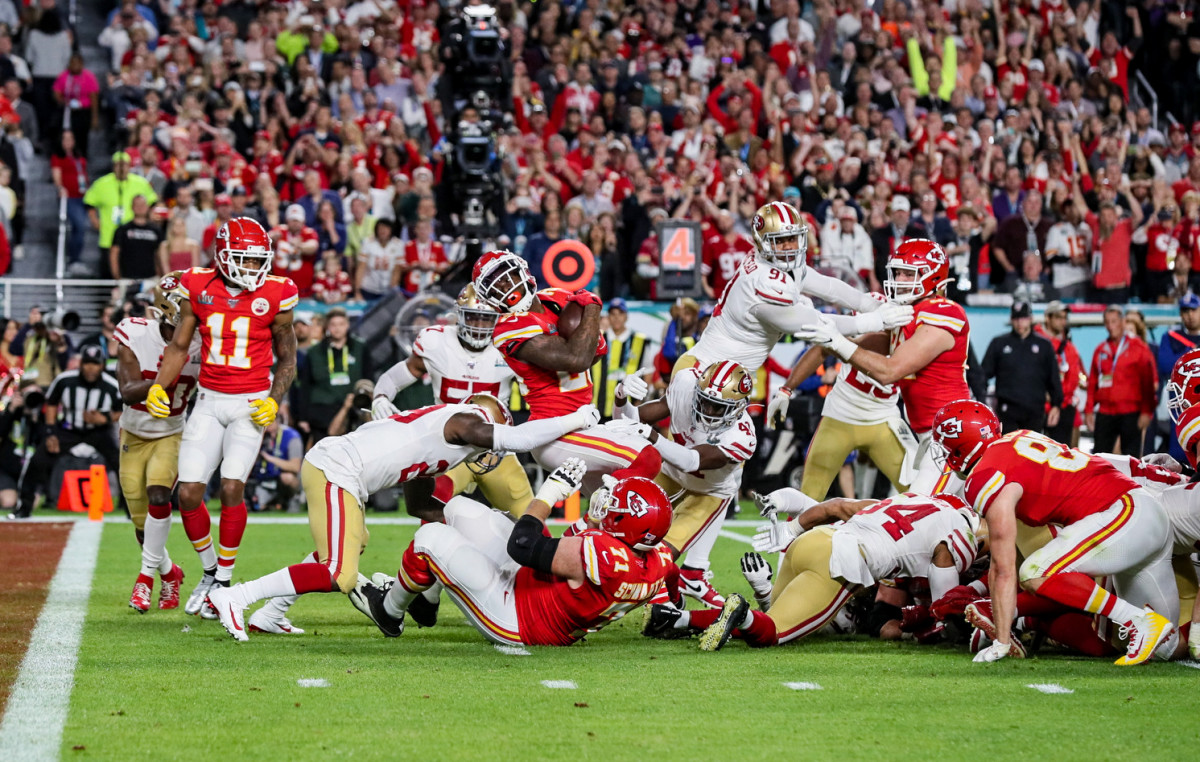
Damien Williams.
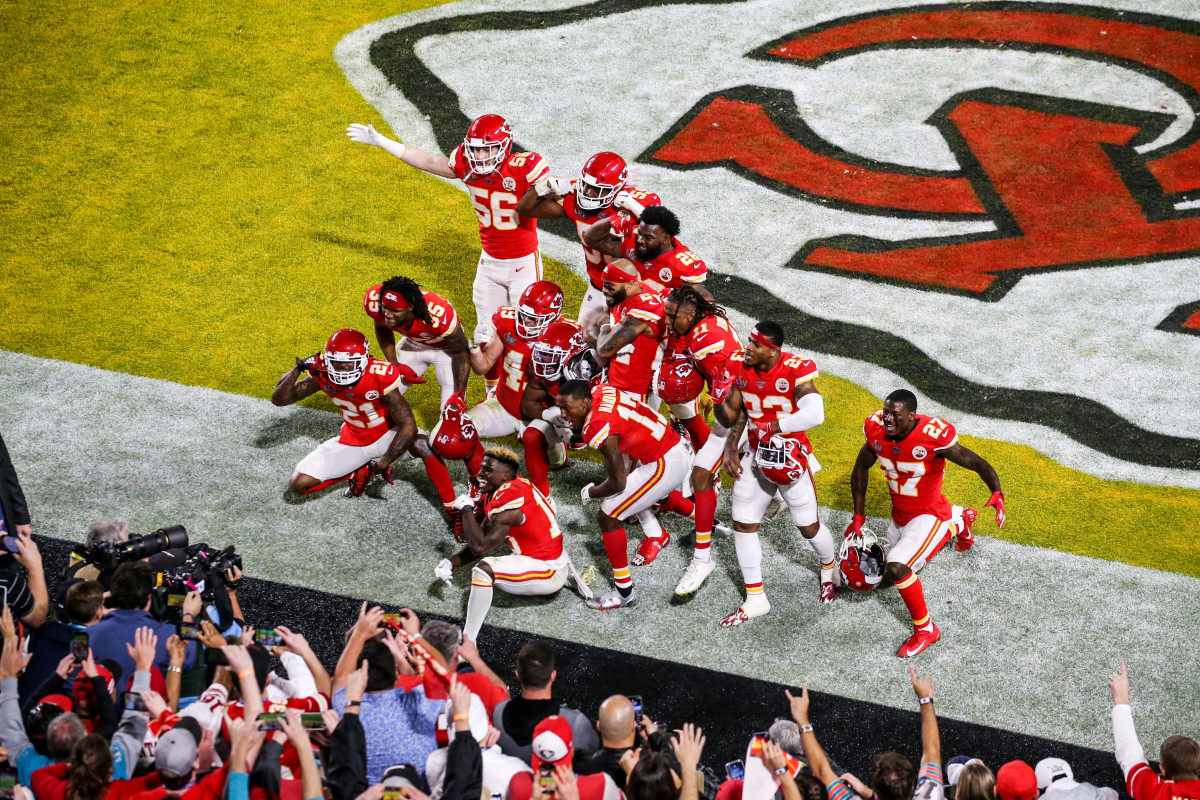
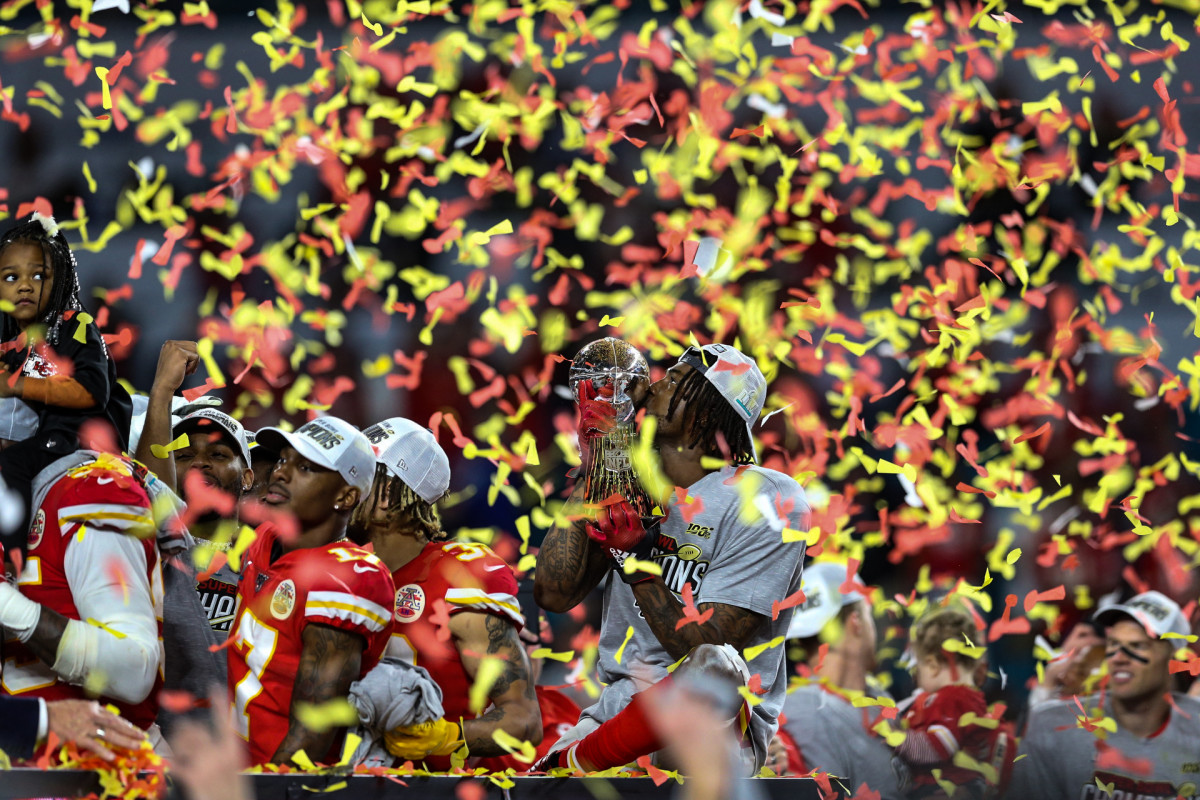
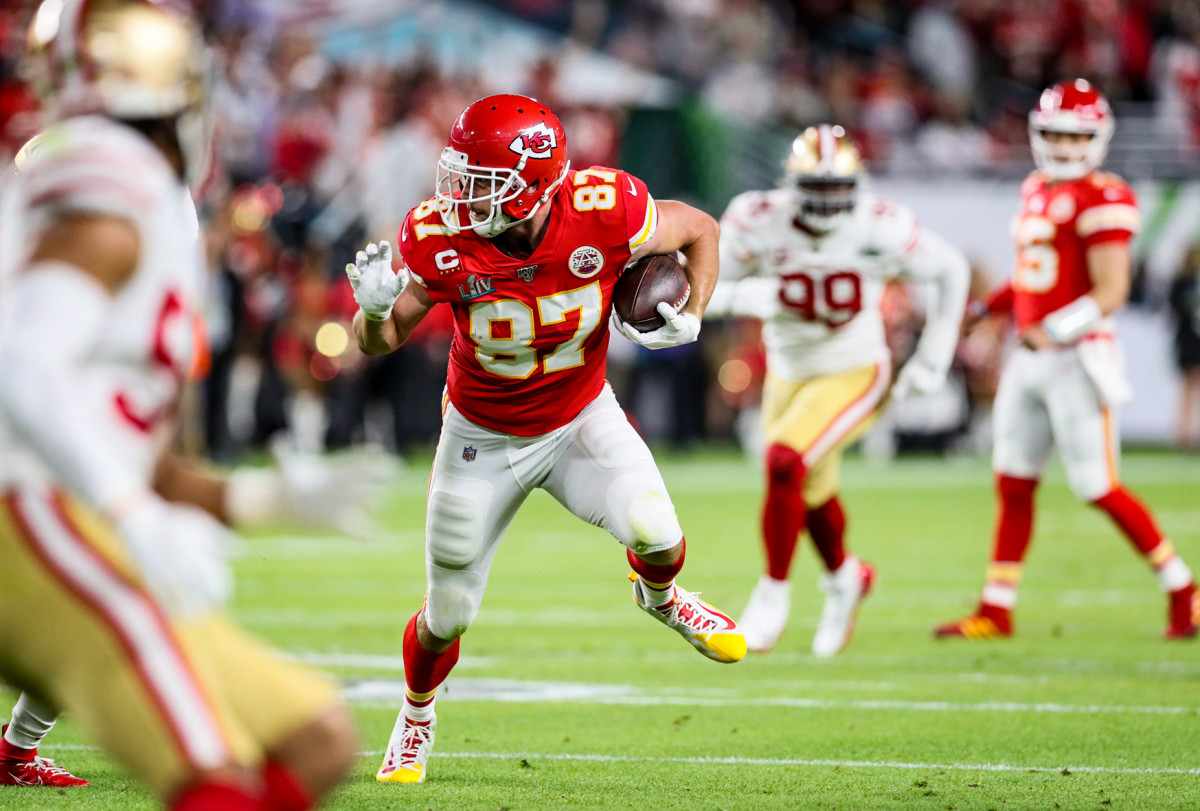
Travis Kelce.
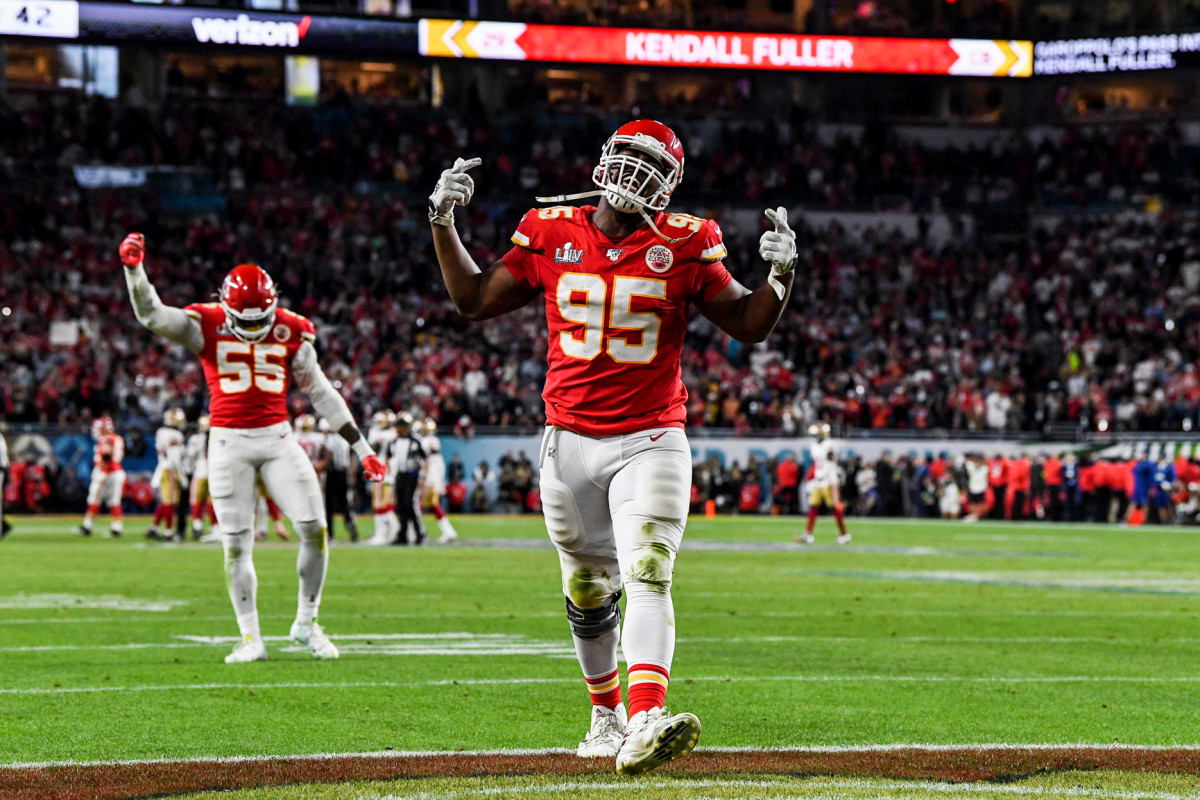
Chris Jones.
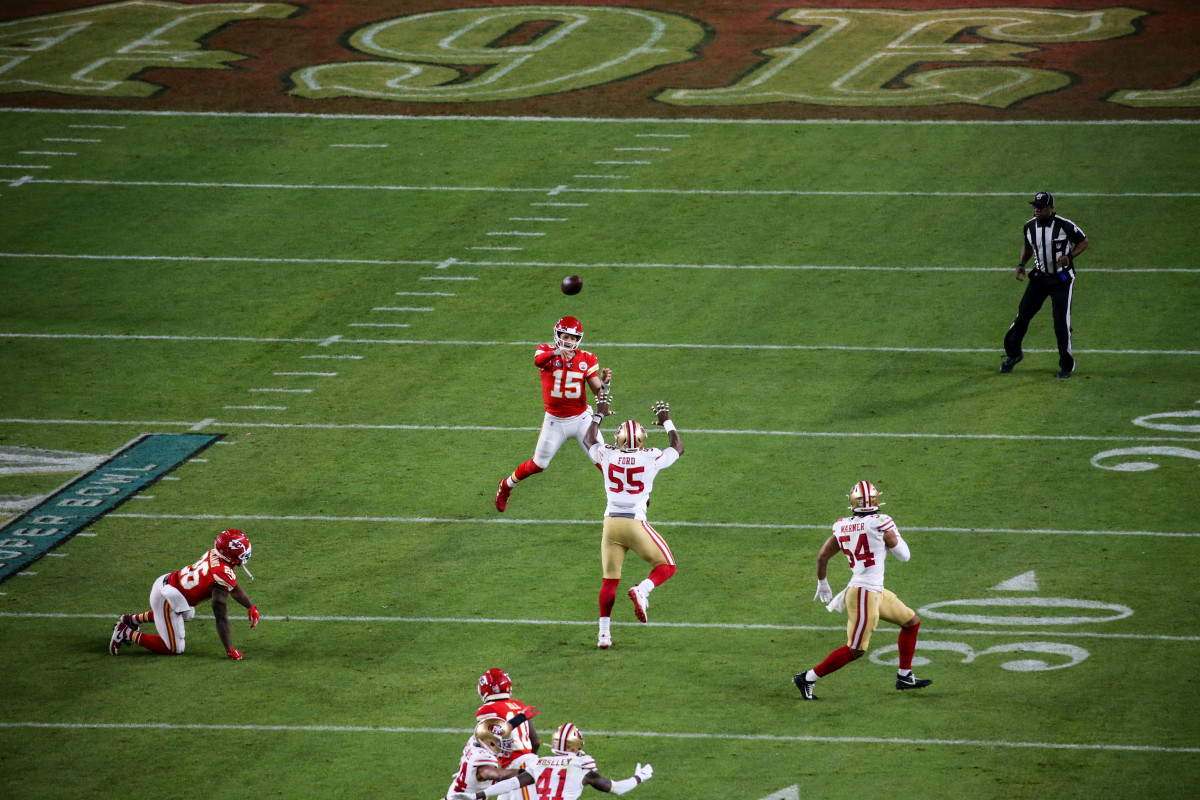
Patrick Mahomes.
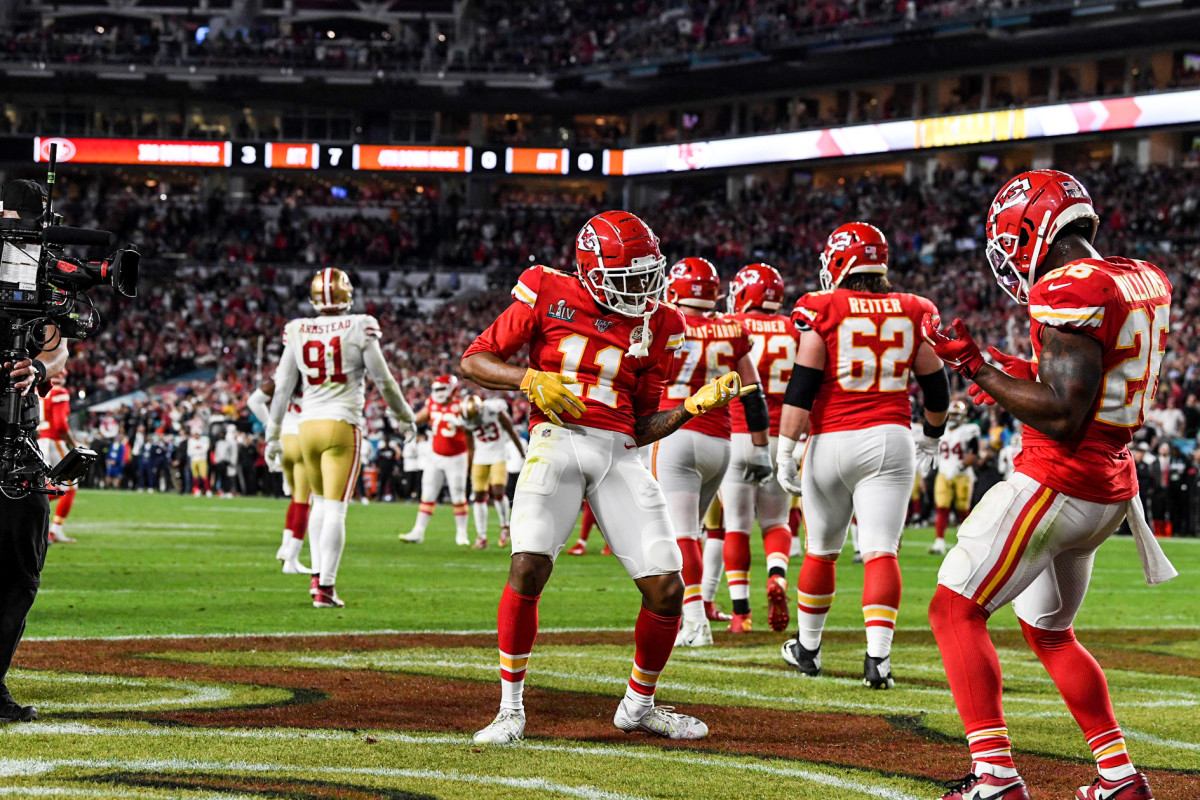
Demarcus Robinson.
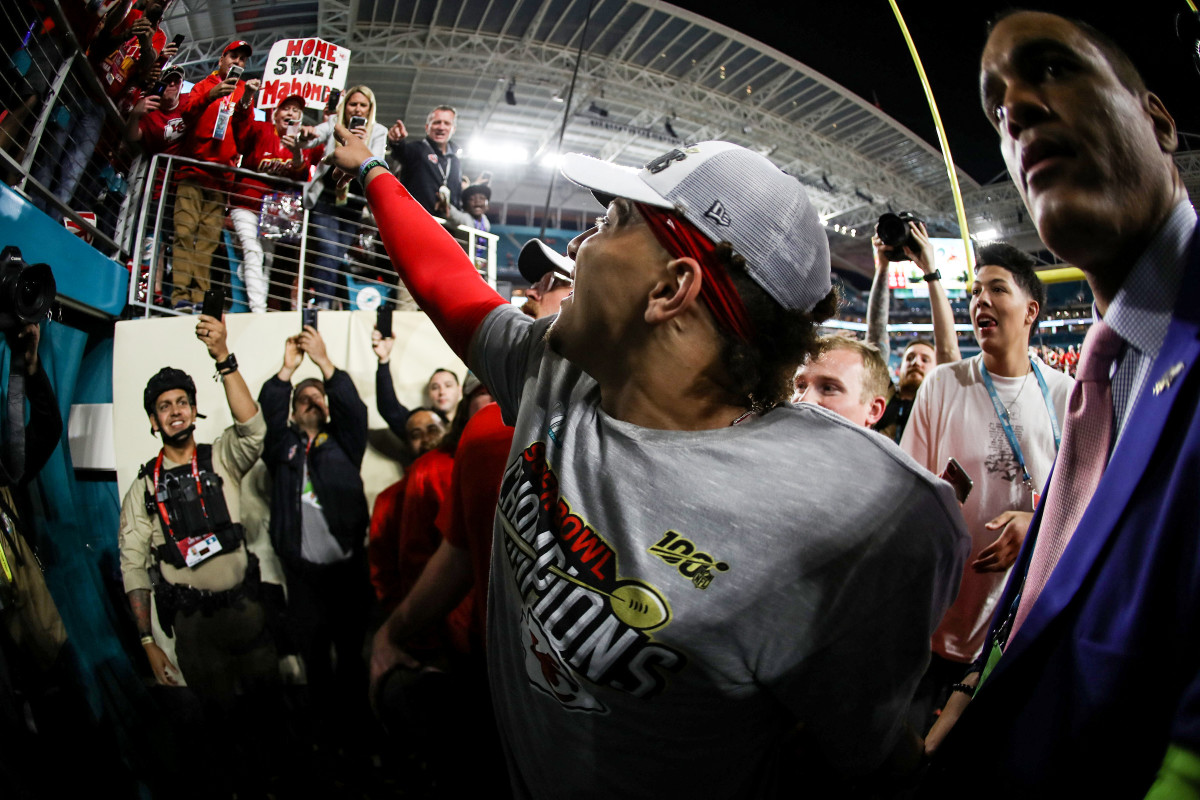
Patrick Mahomes.
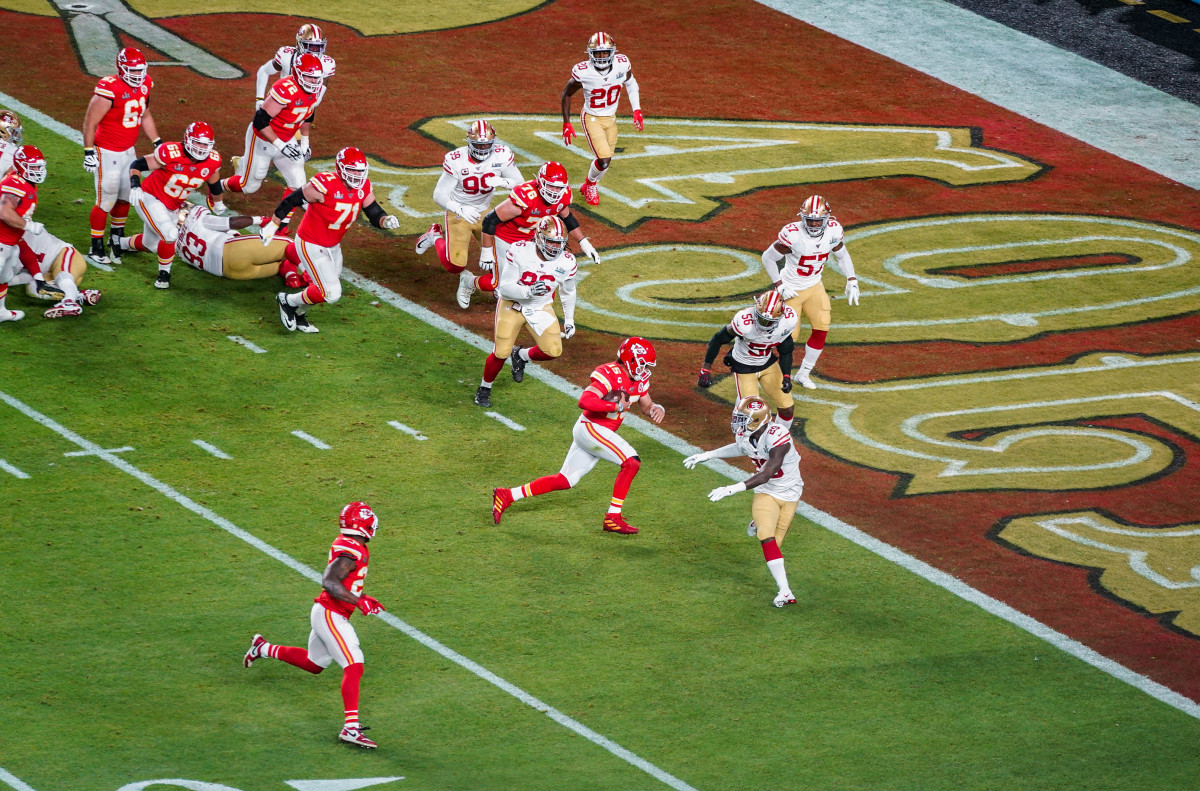
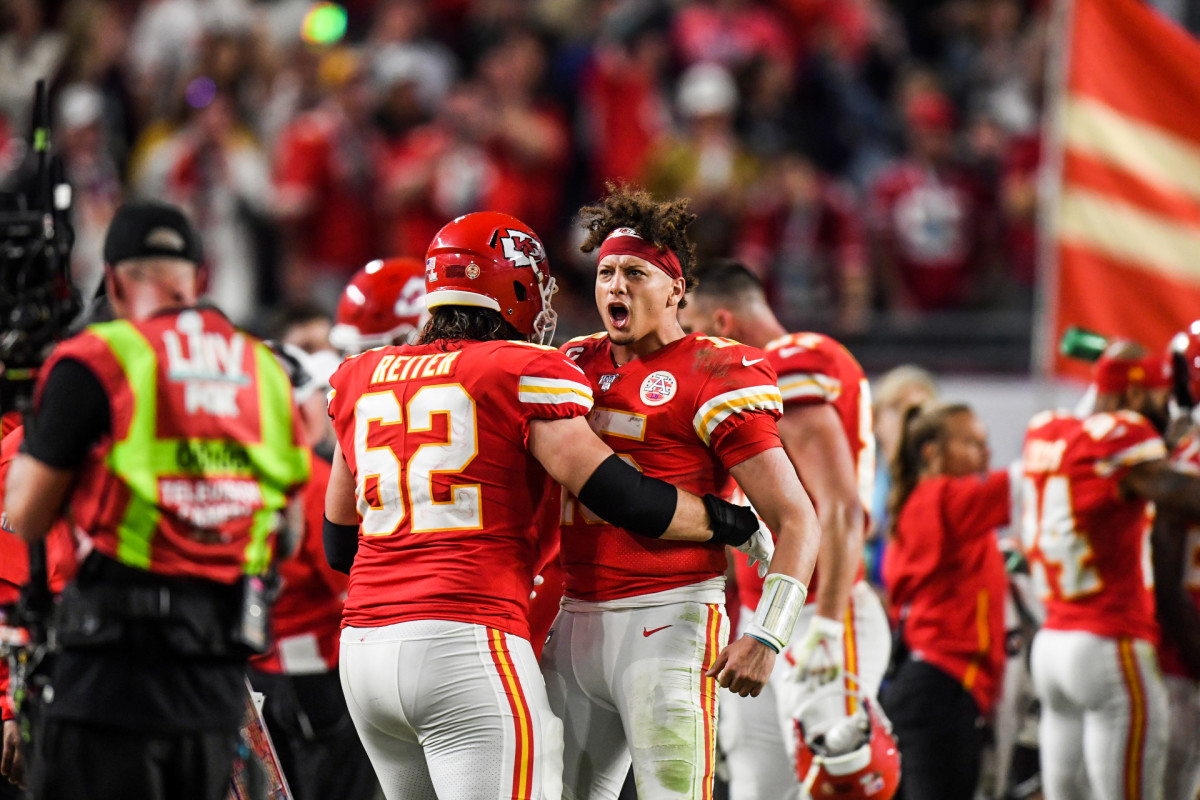
Patrick Mahomes.
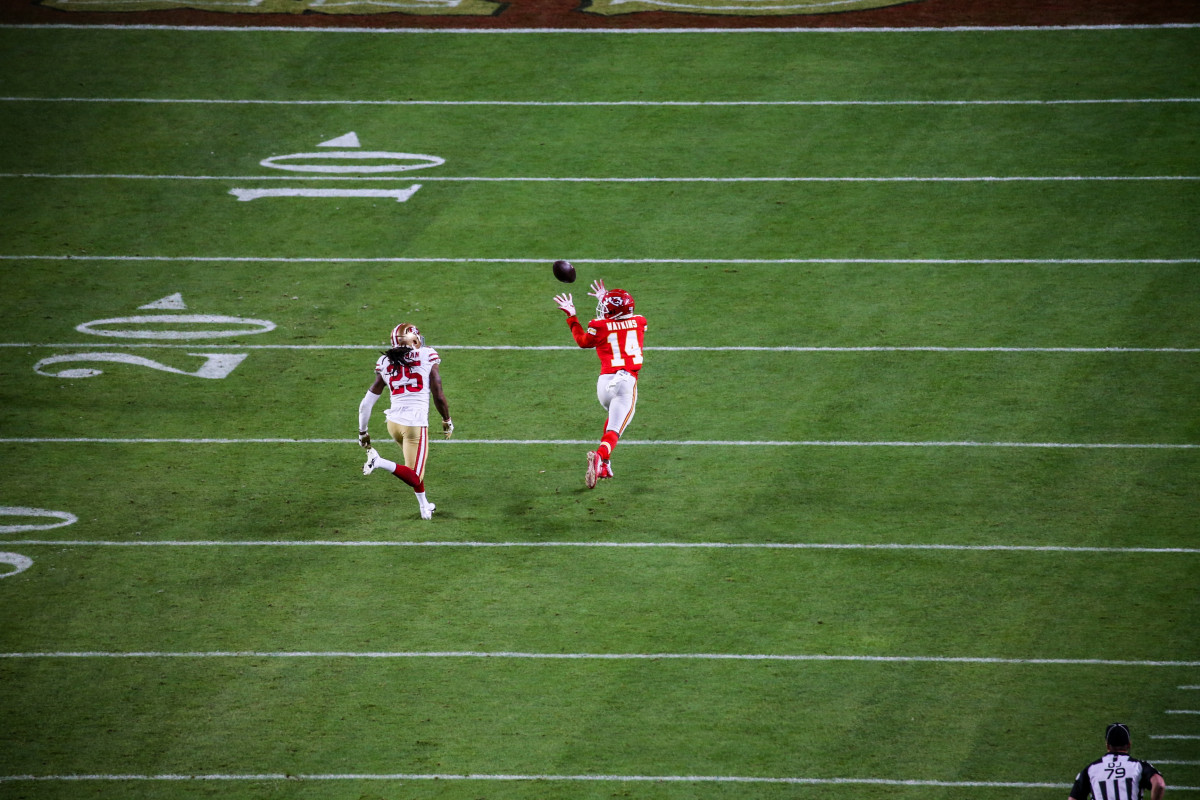
Sammy Watkins.
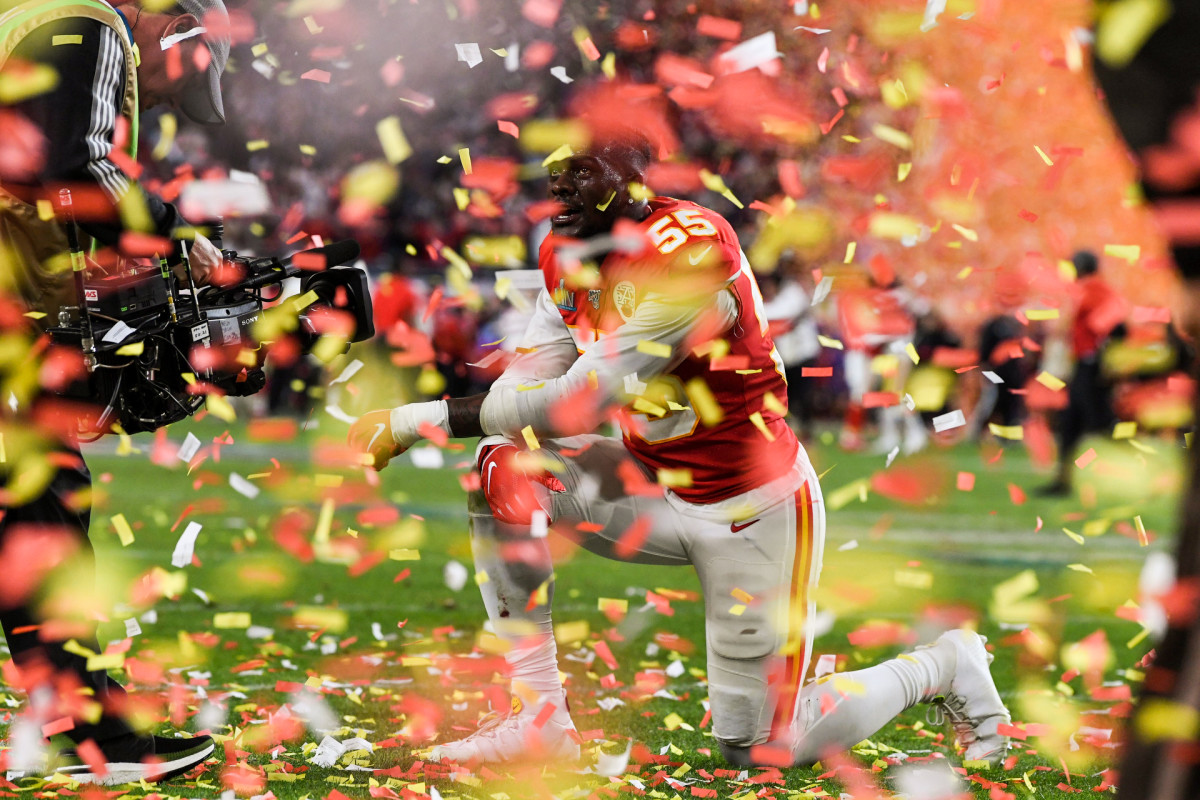
Frank Clark.
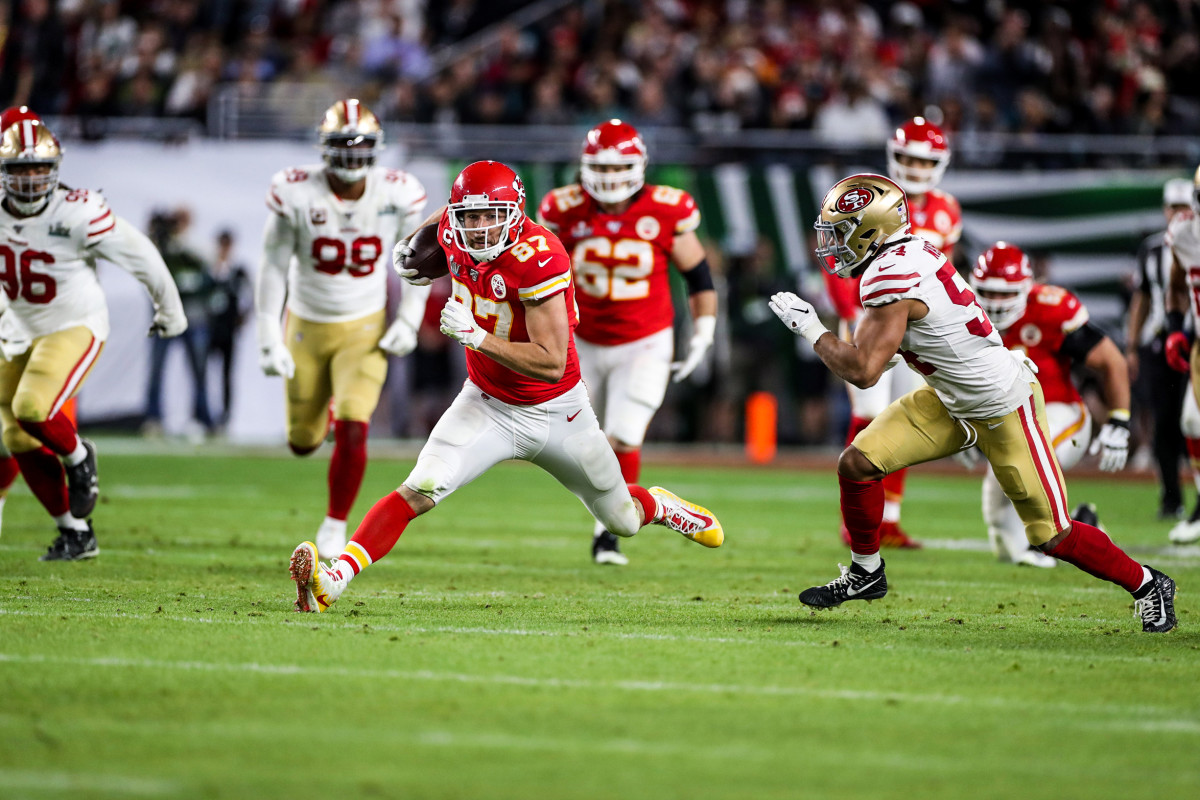
Travis Kelce.
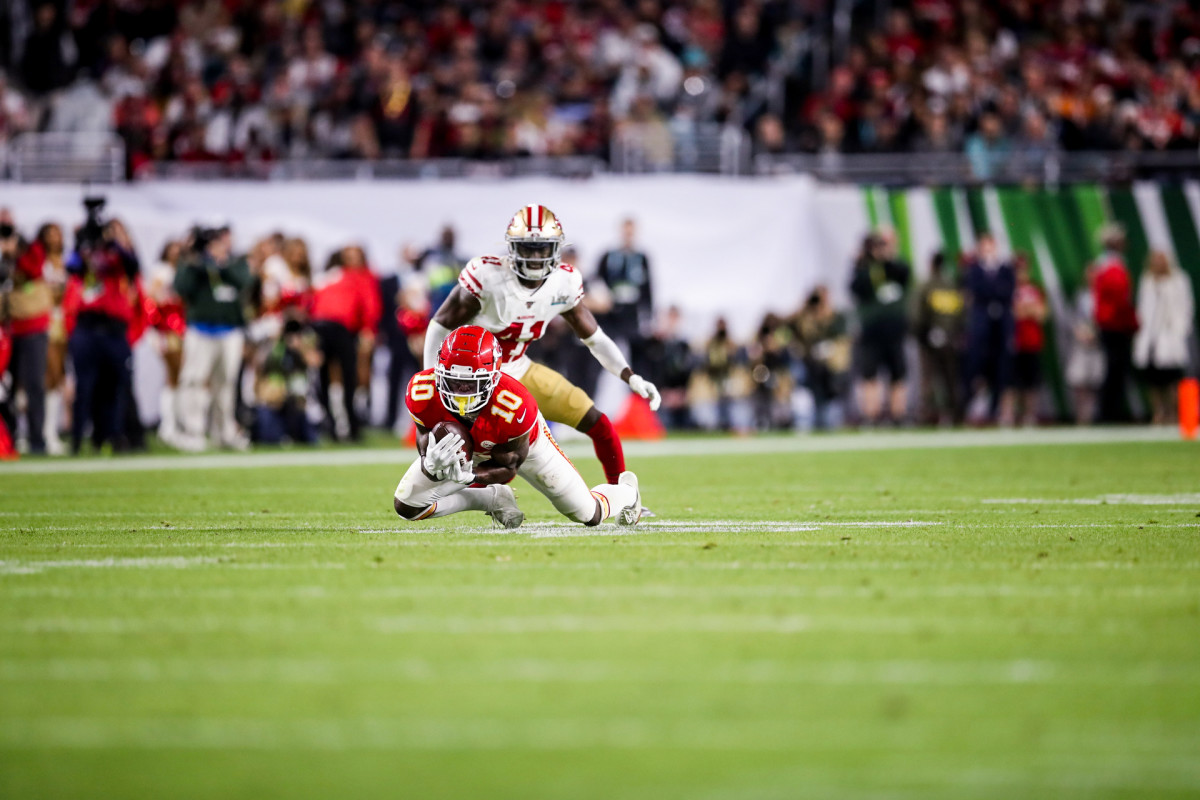
Tyreek Hill.
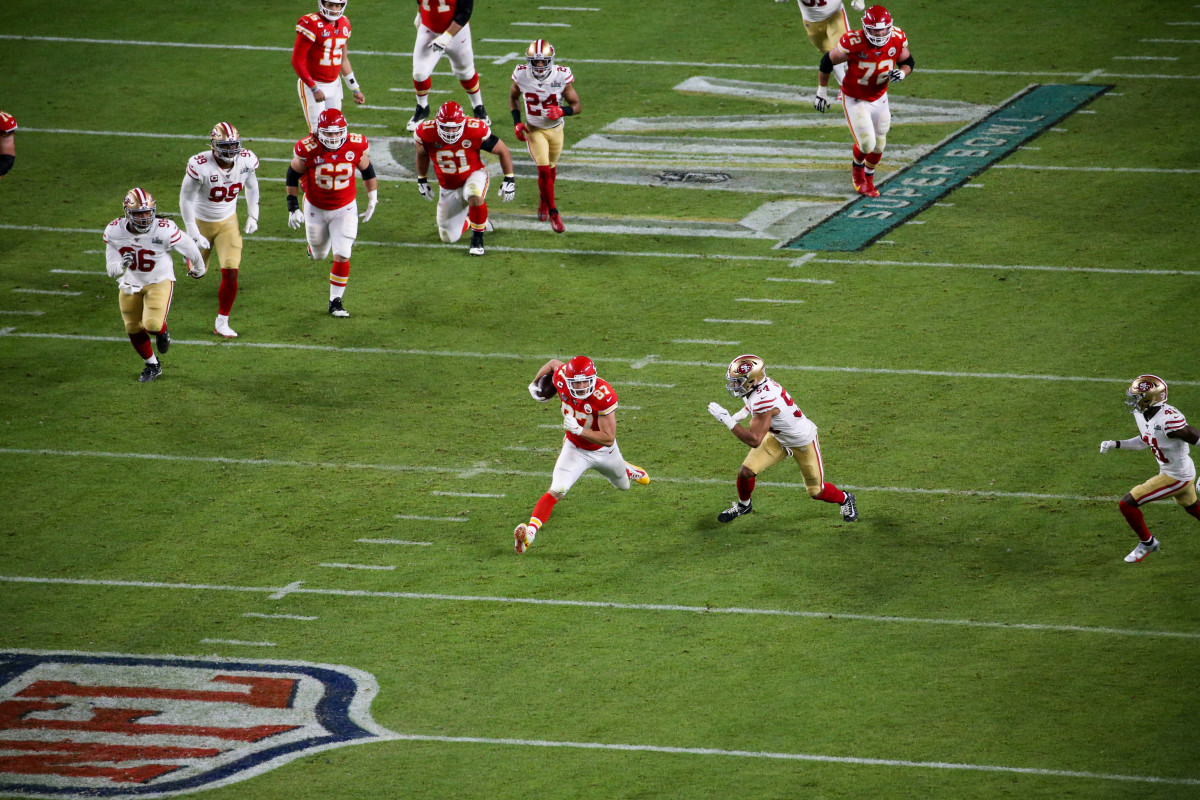
Travis Kelce.
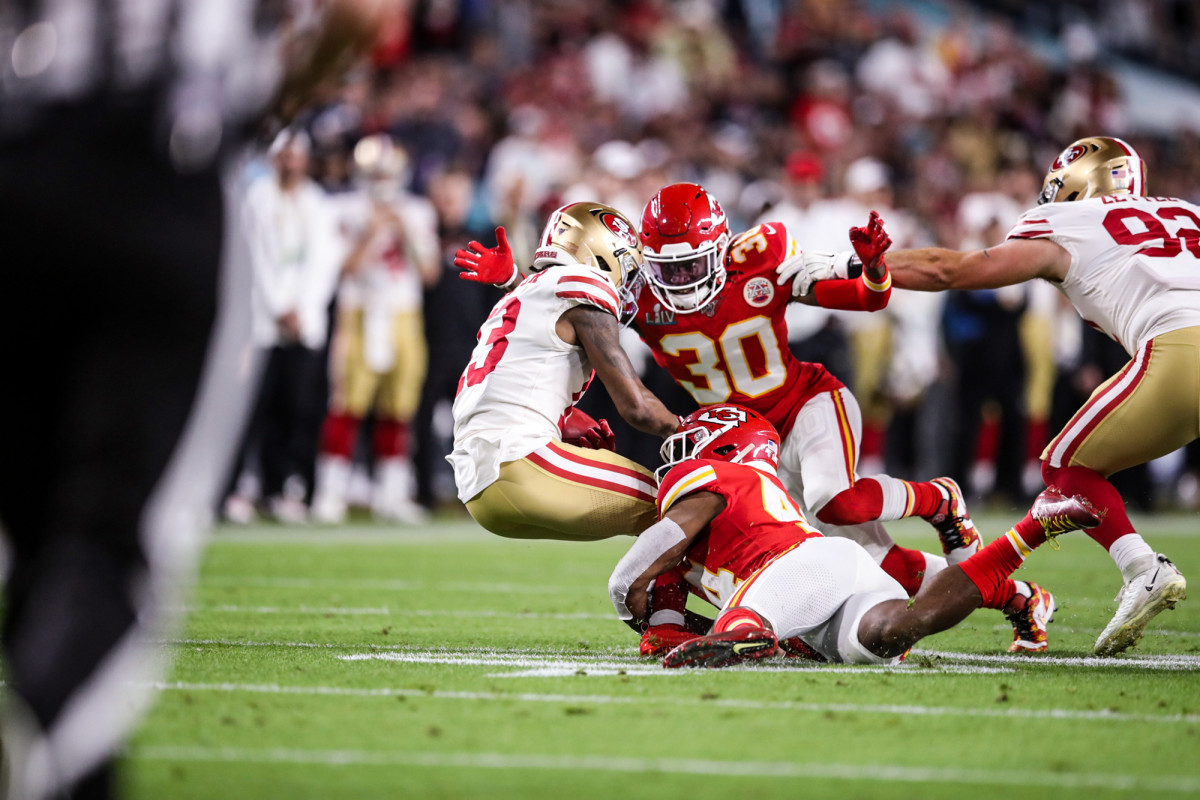
Chiefs defense.
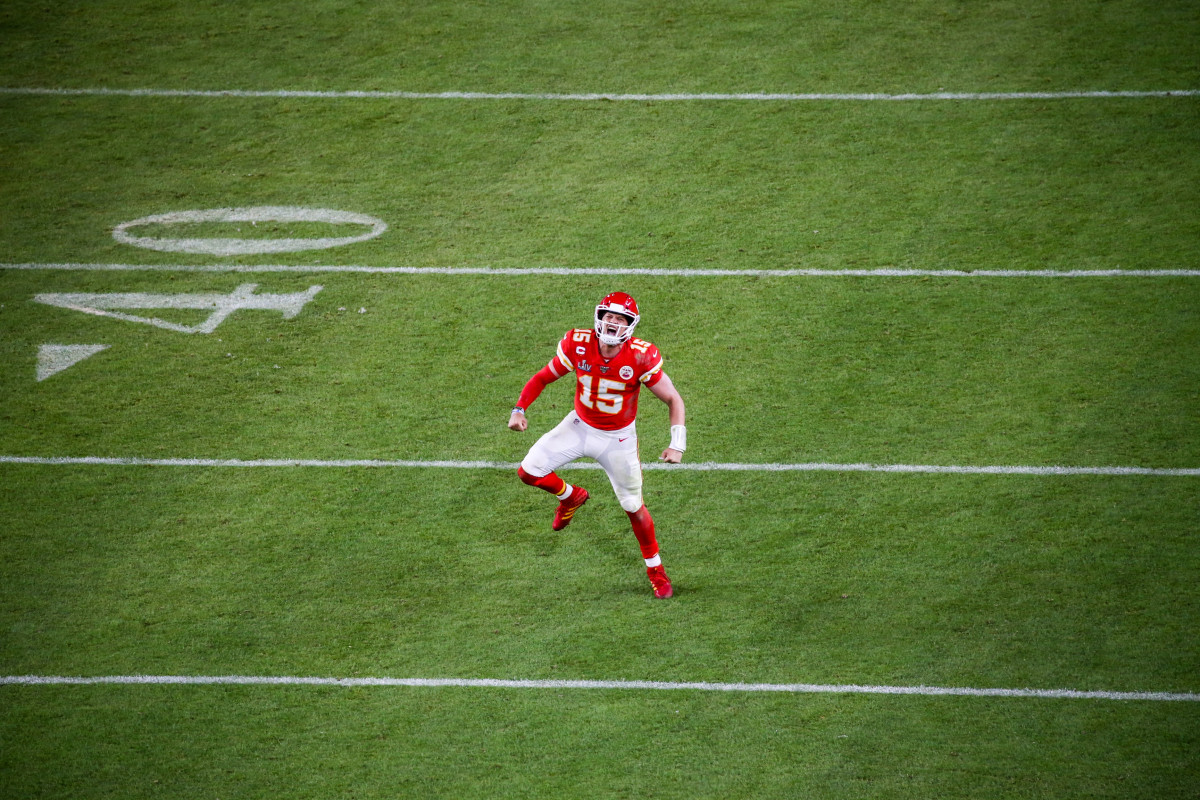
Patrick Mahomes.
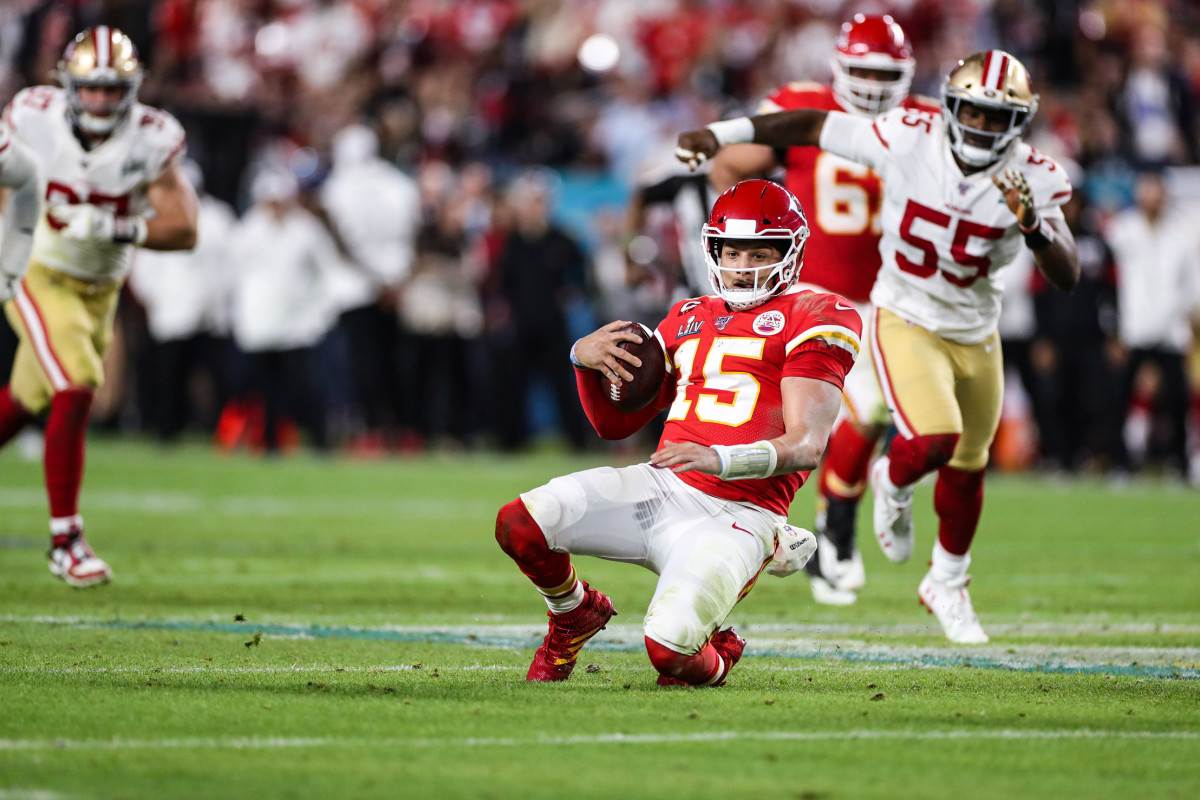
Patrick Mahomes.
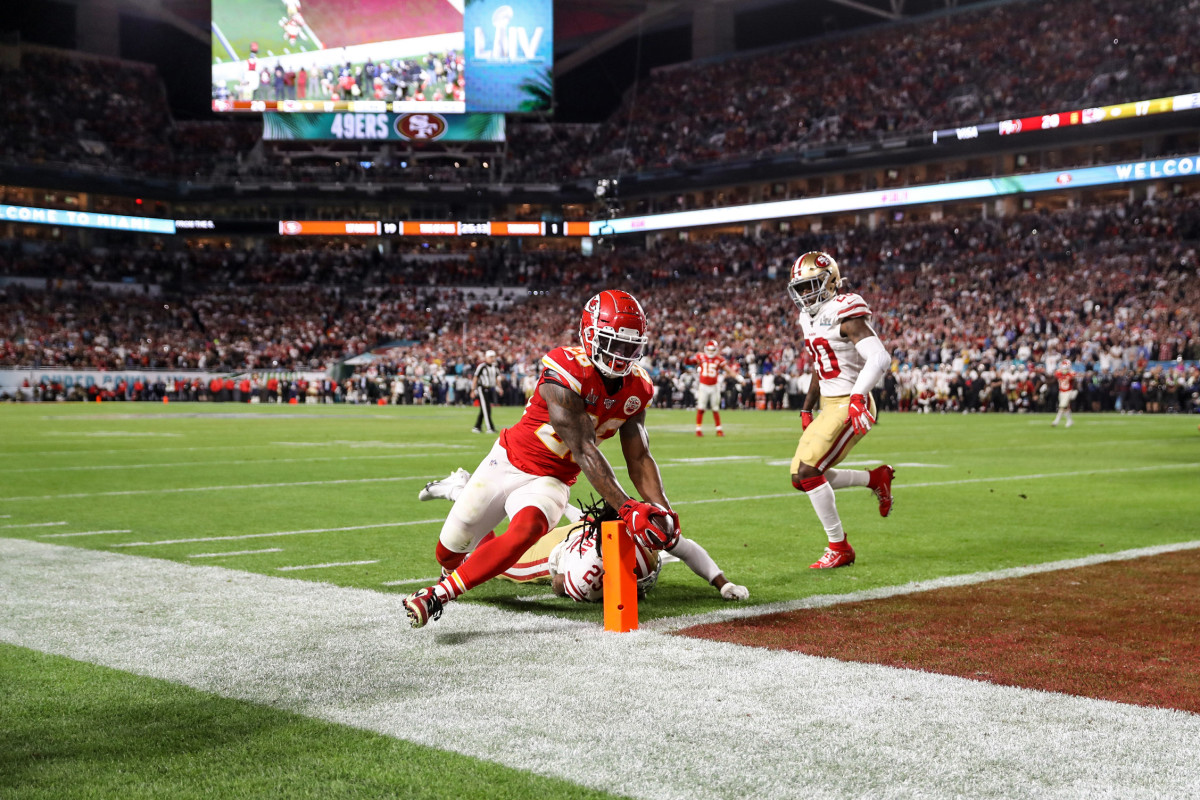
Damien Williams.
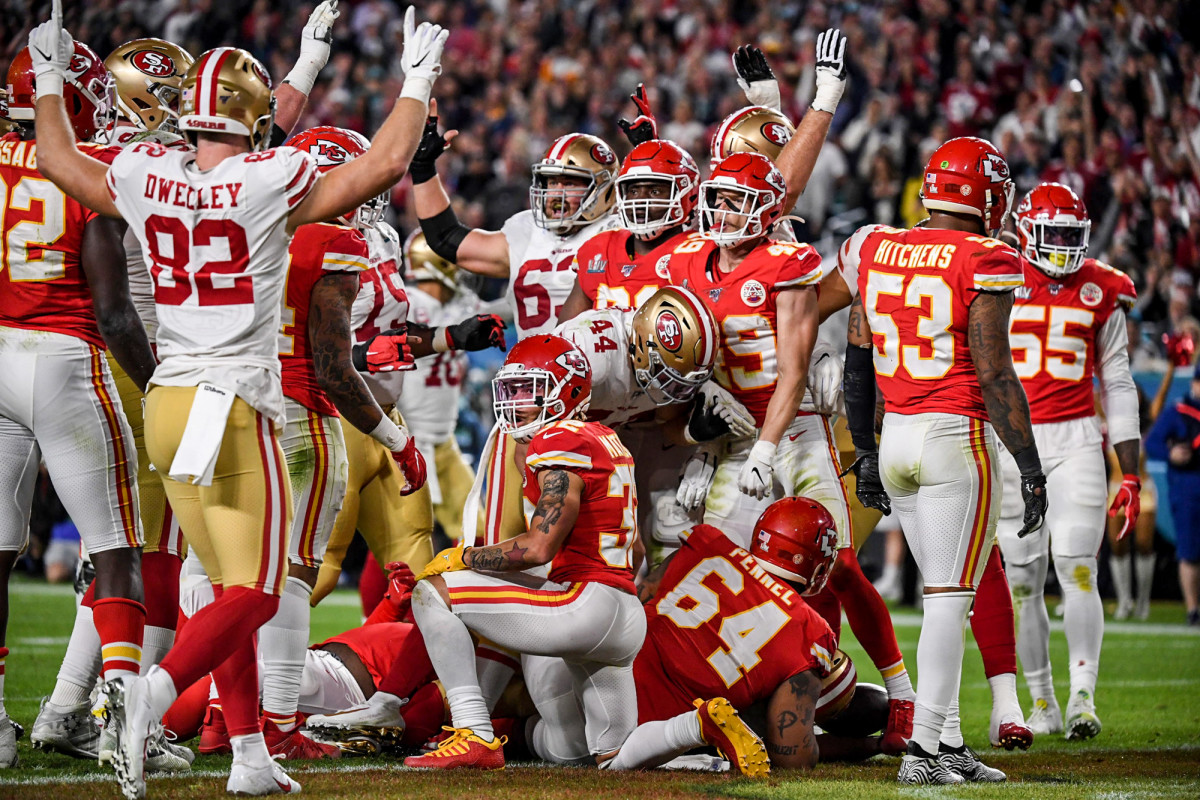
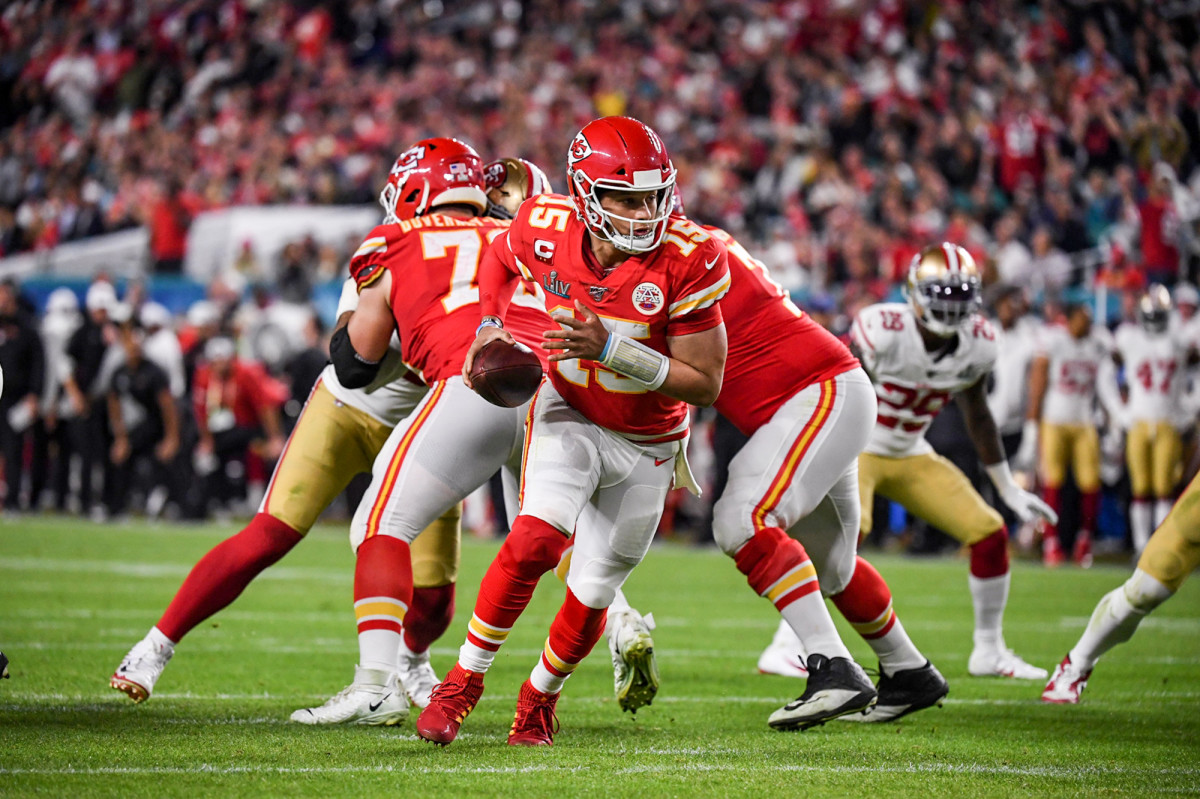
Patrick Mahomes.
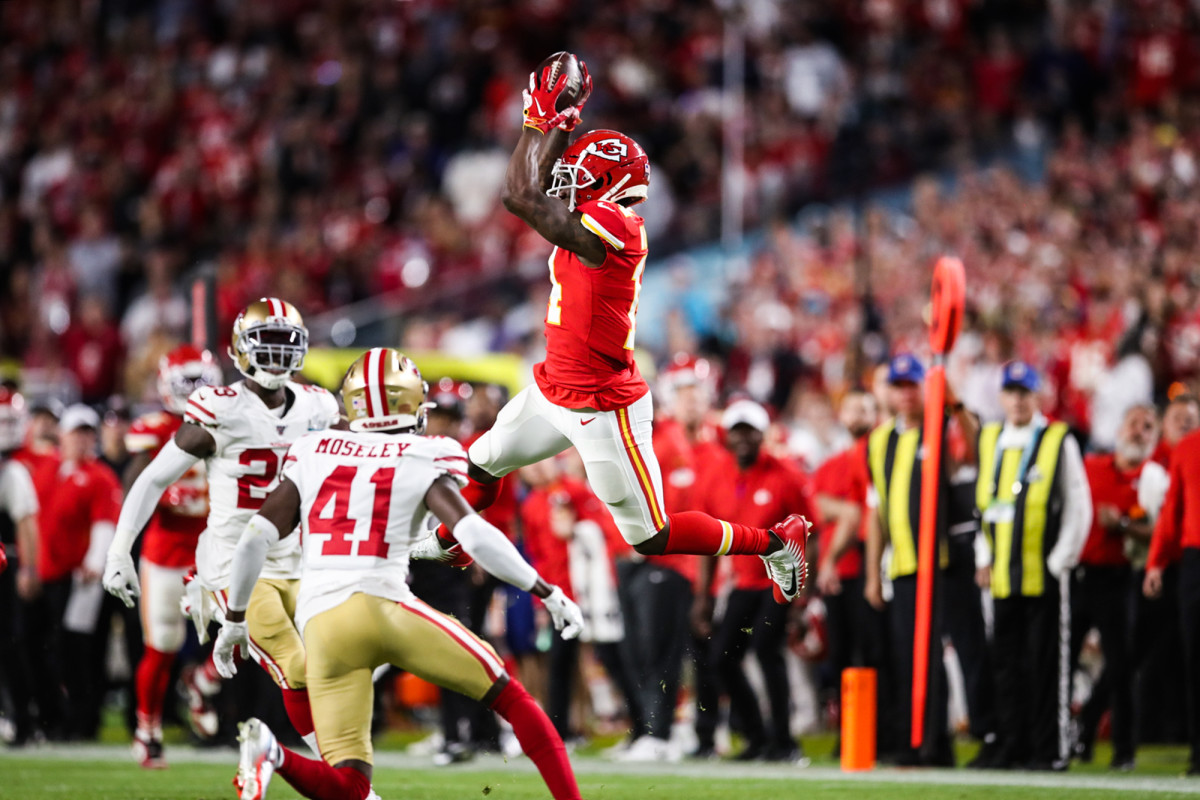
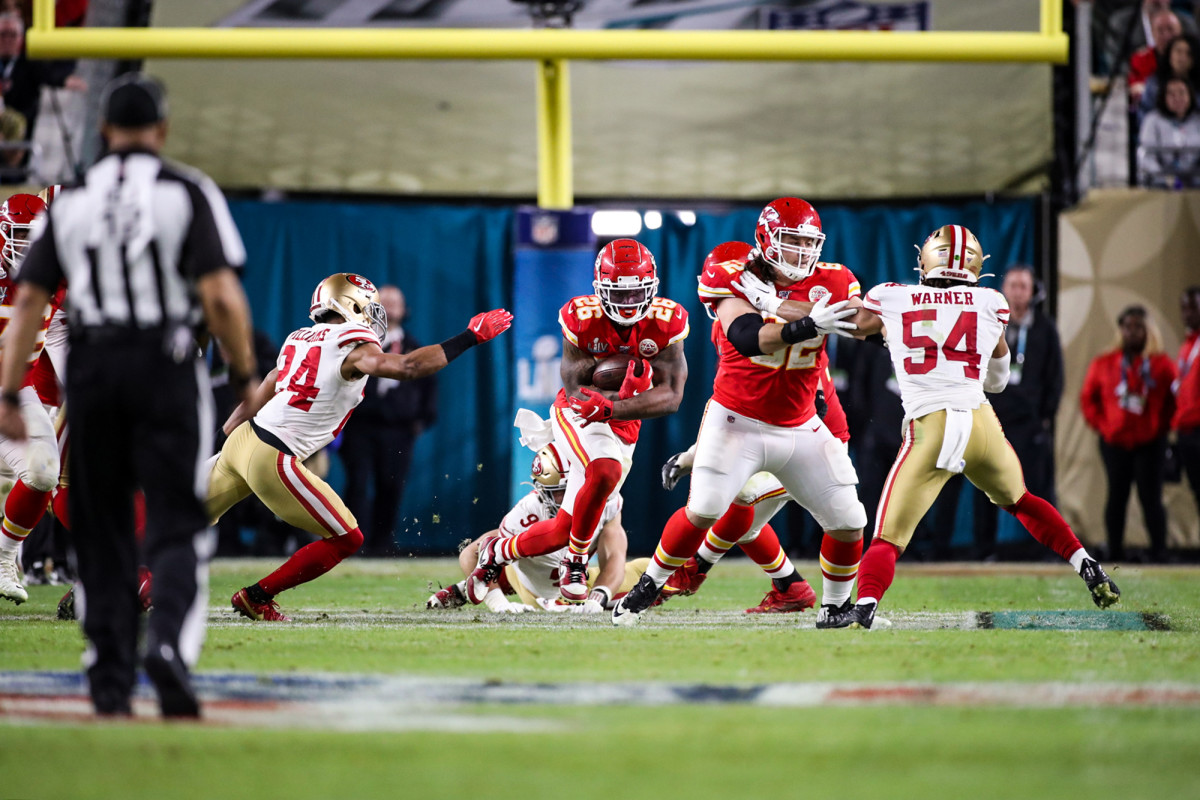
Damien Williams.
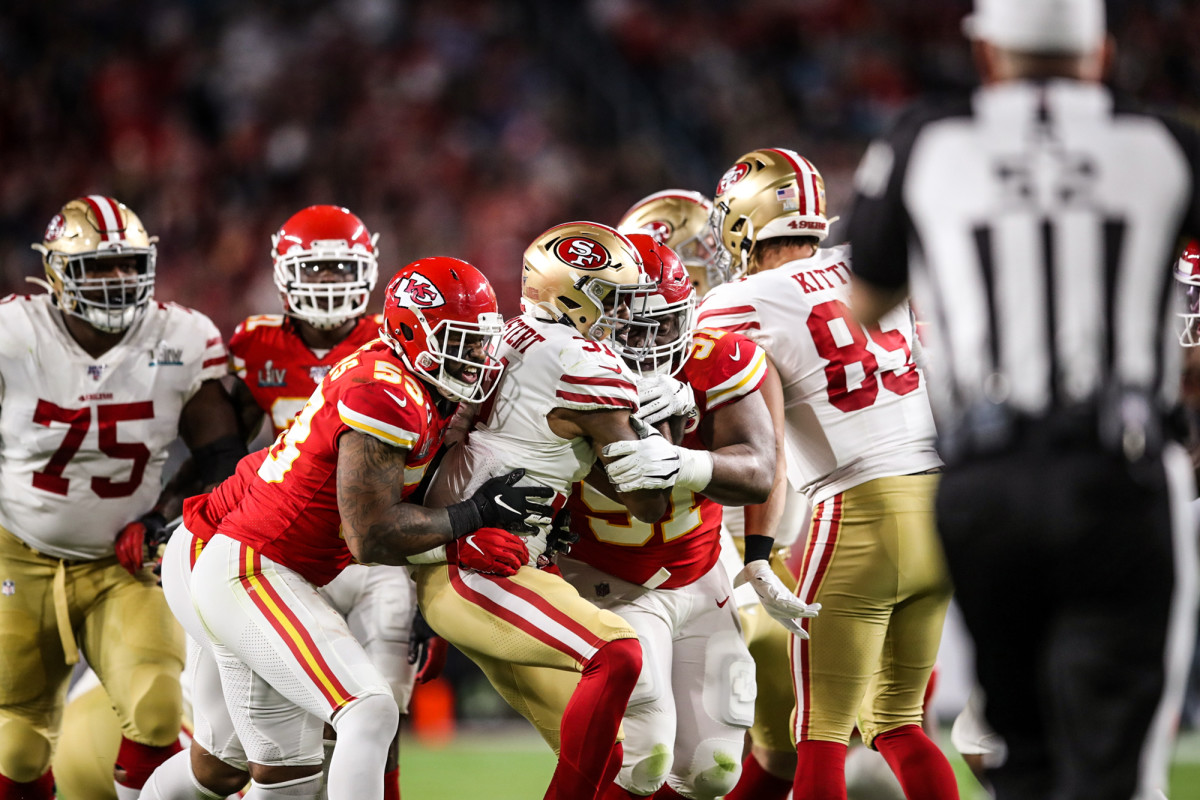
Chiefs defense.
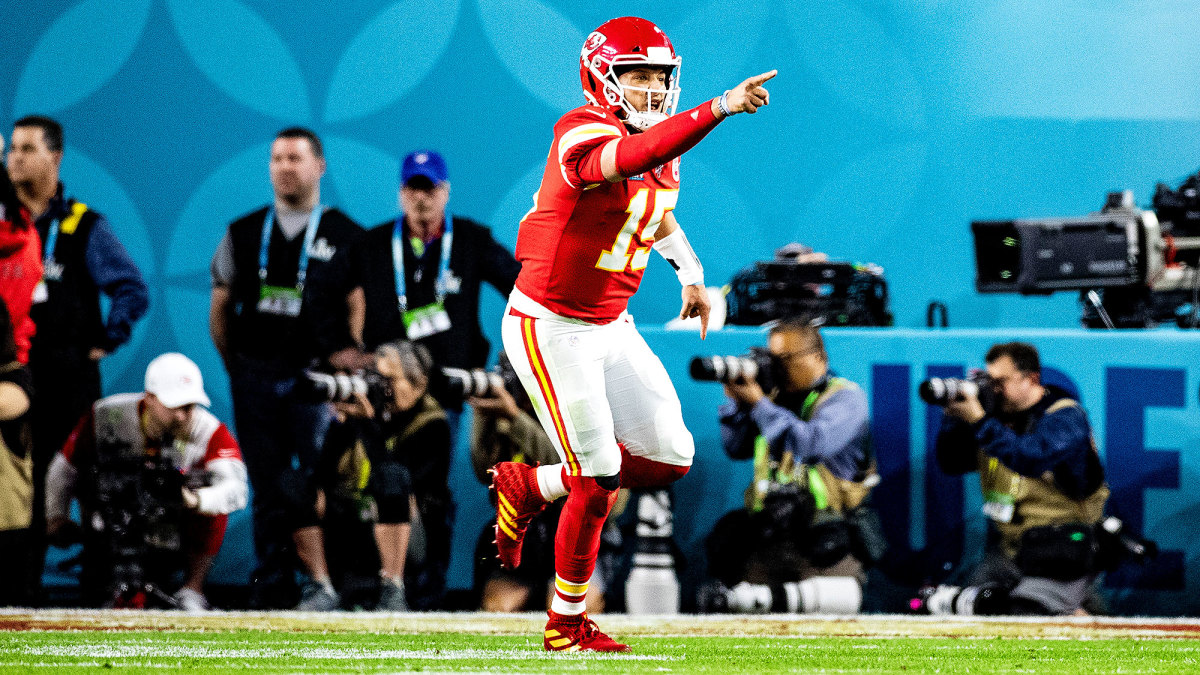
Patrick Mahomes.
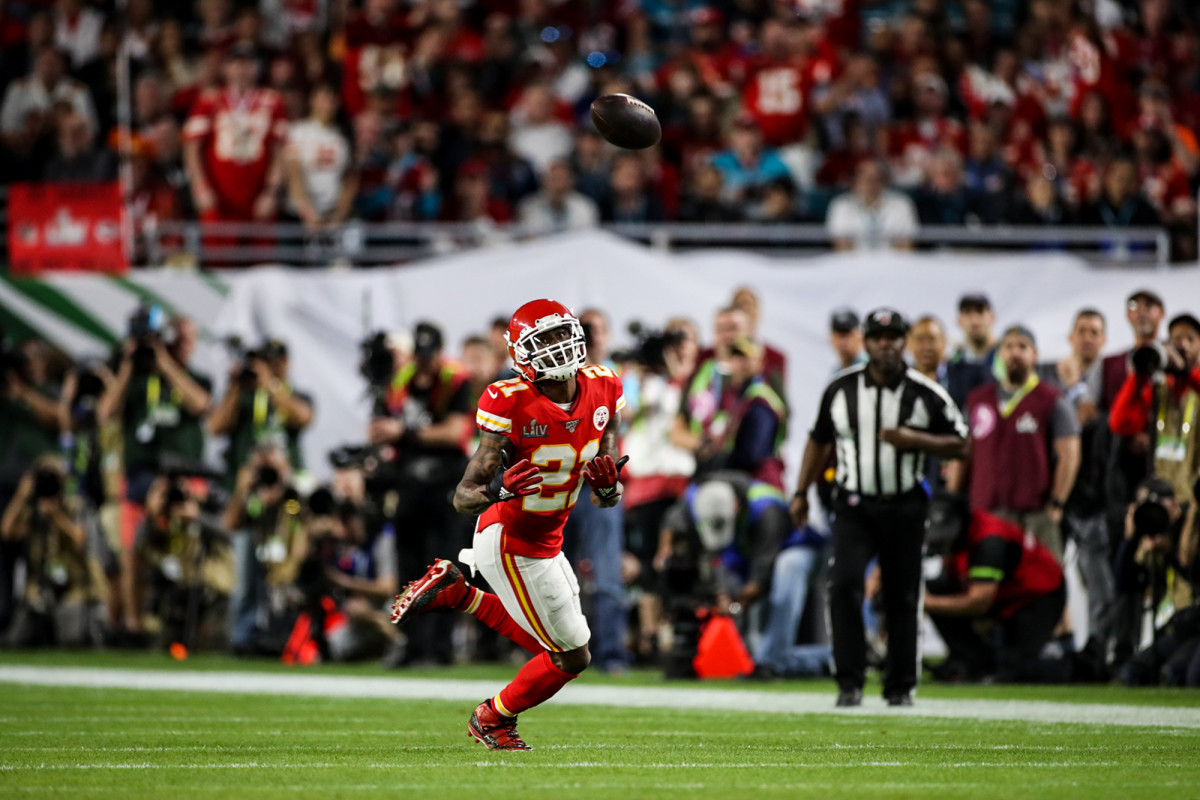
Bashaud Breeland.
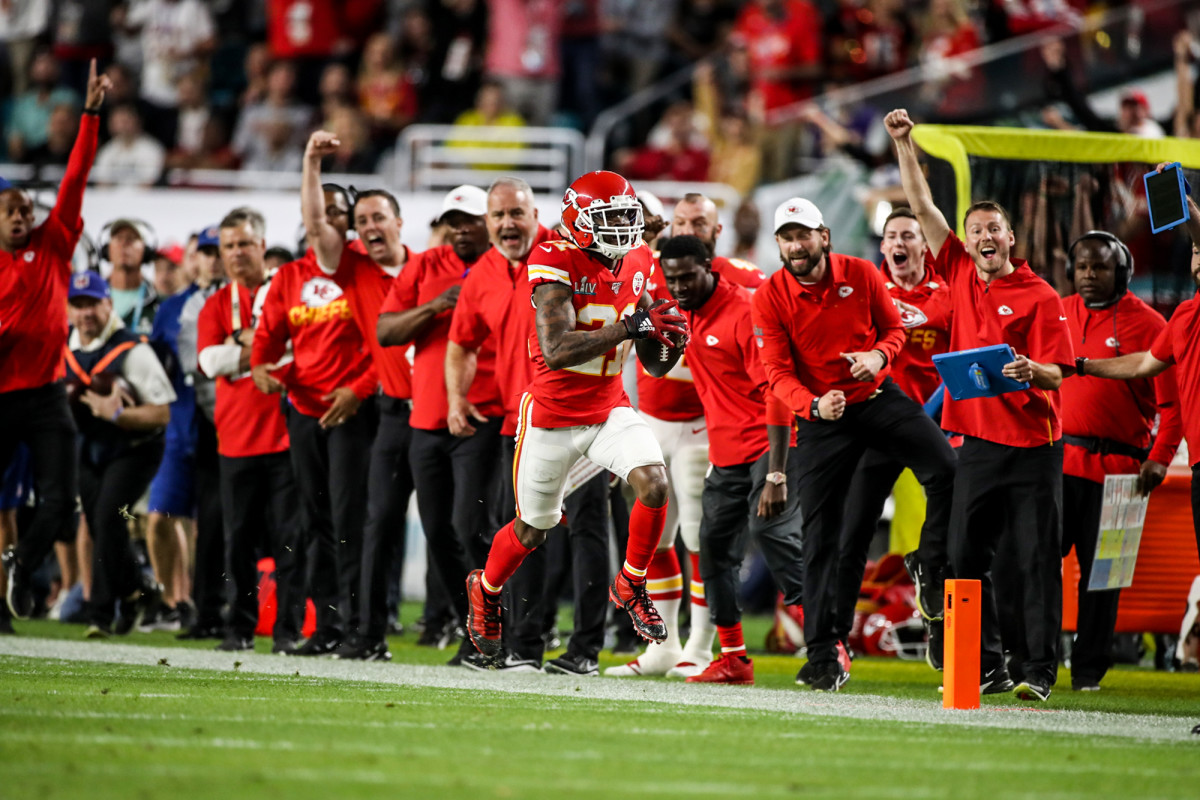
Bashaud Breeland.
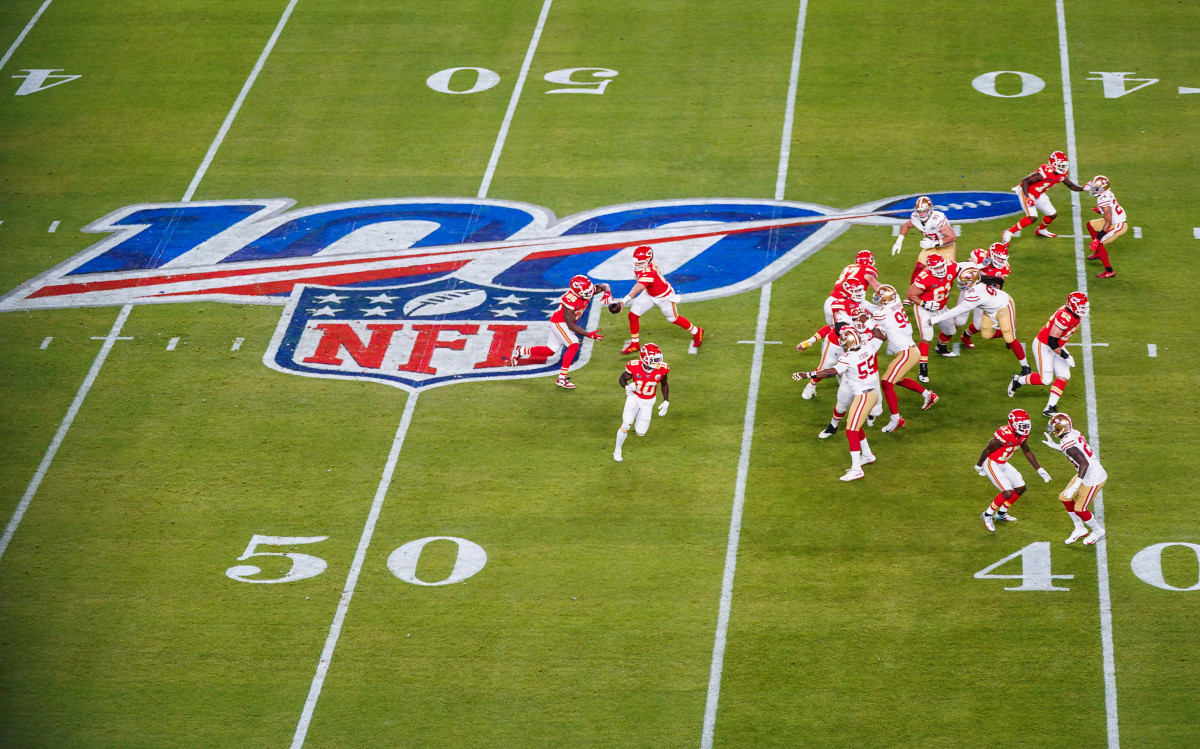
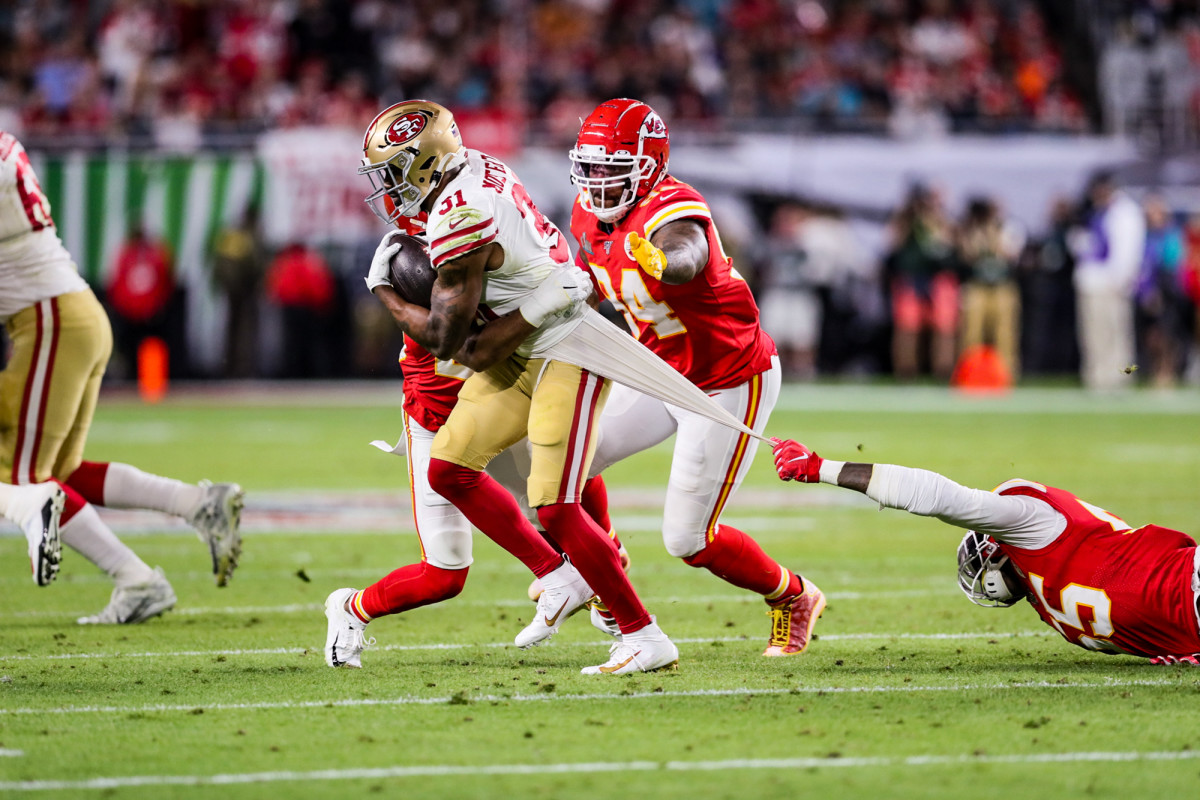
Raheem Mostert.
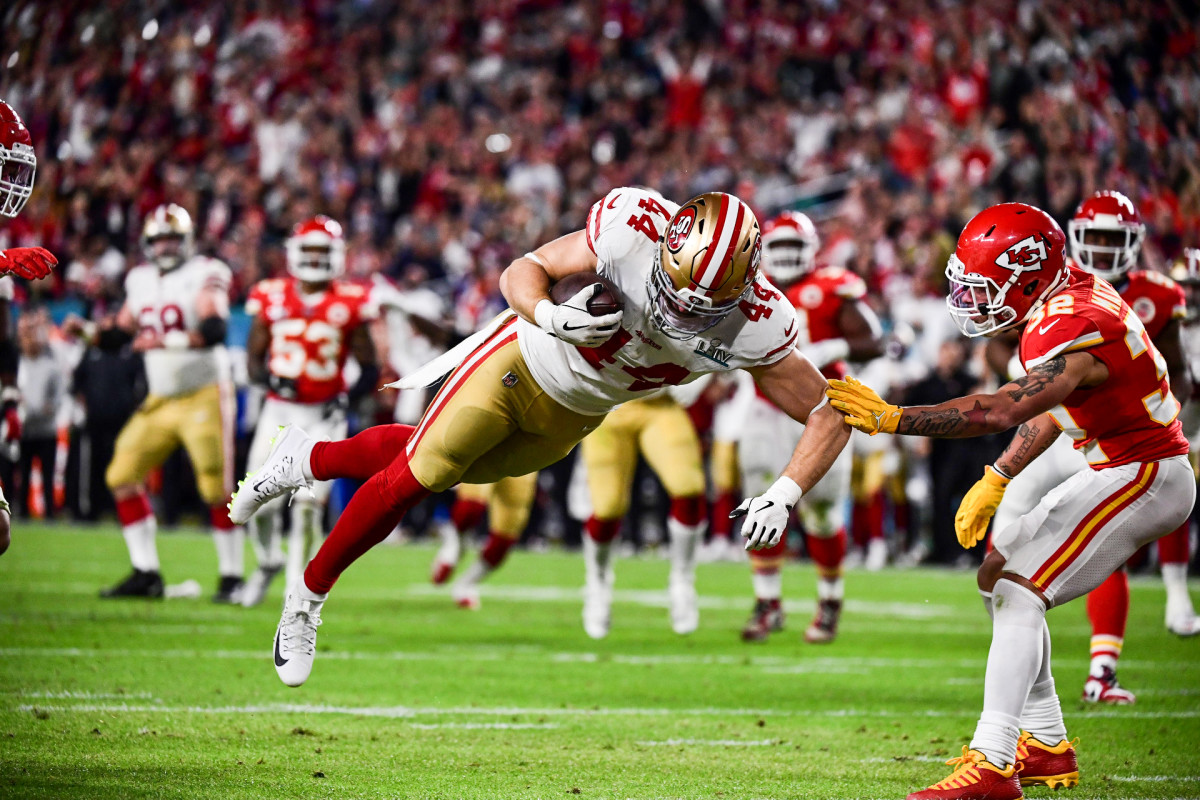
Kyle Juszczyk.
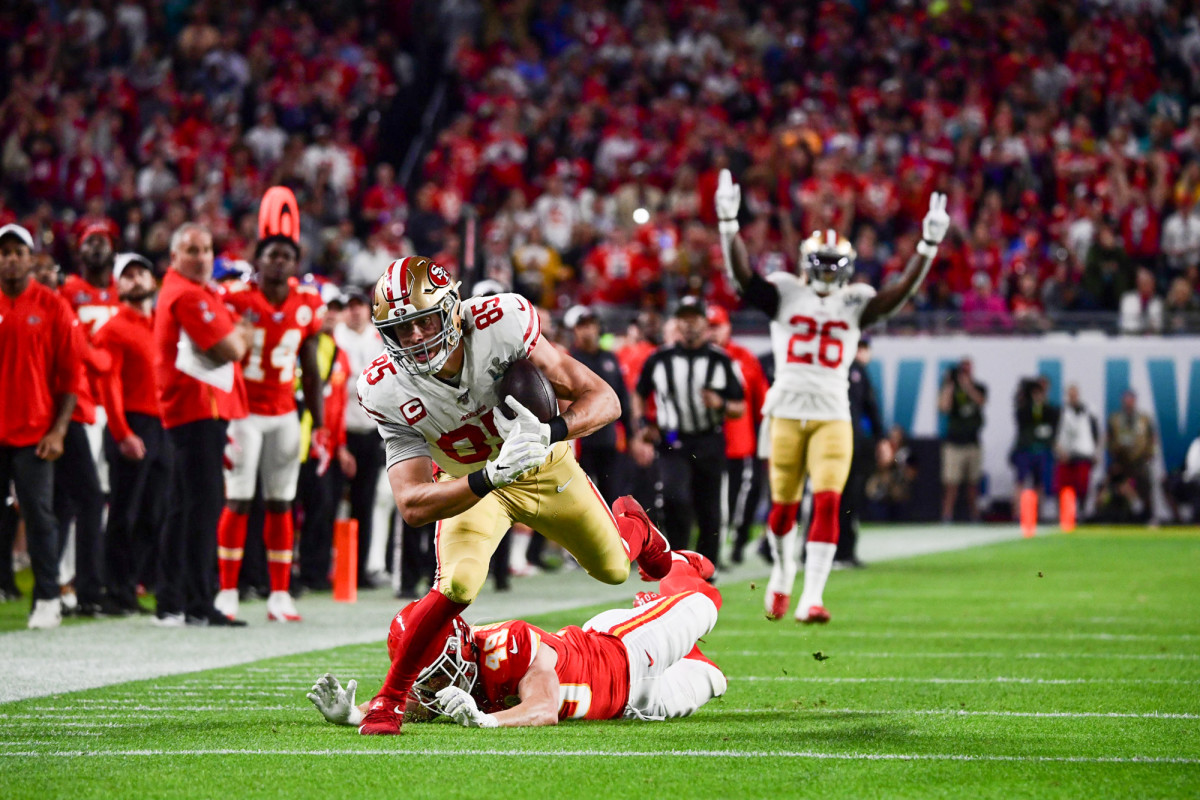
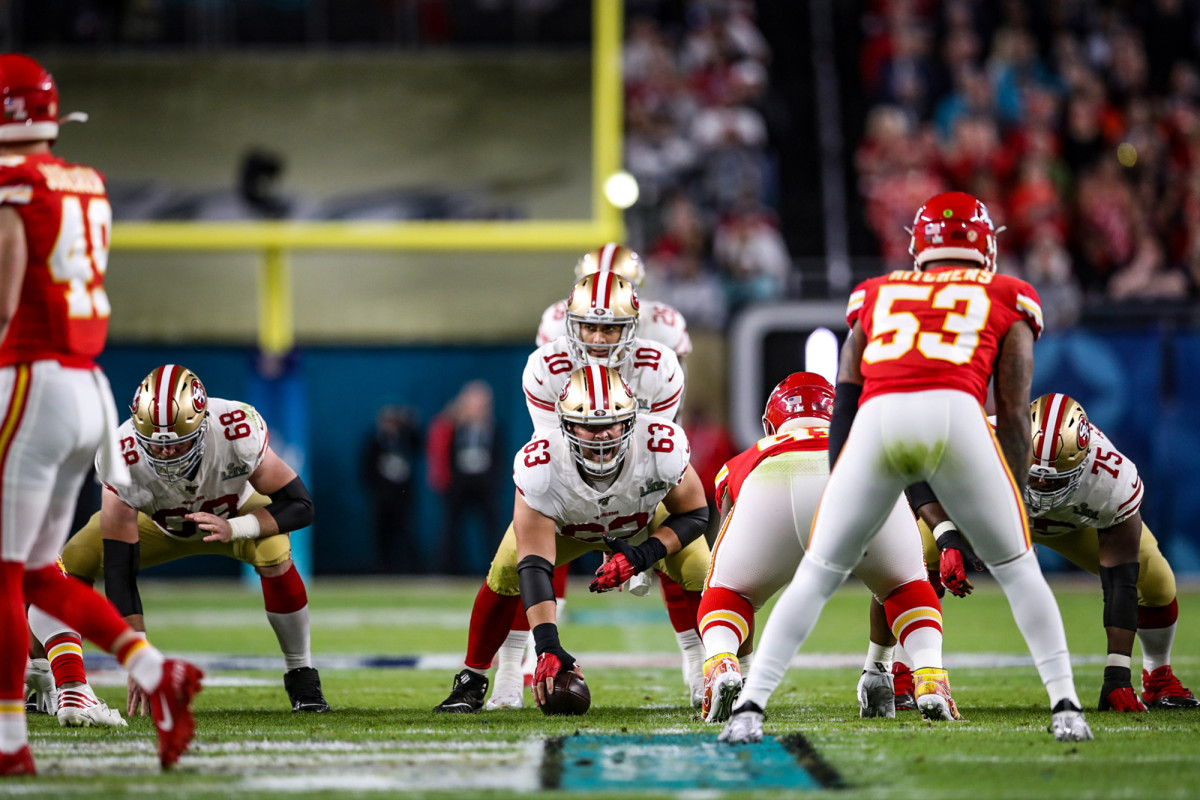
Jimmy Garoppolo.
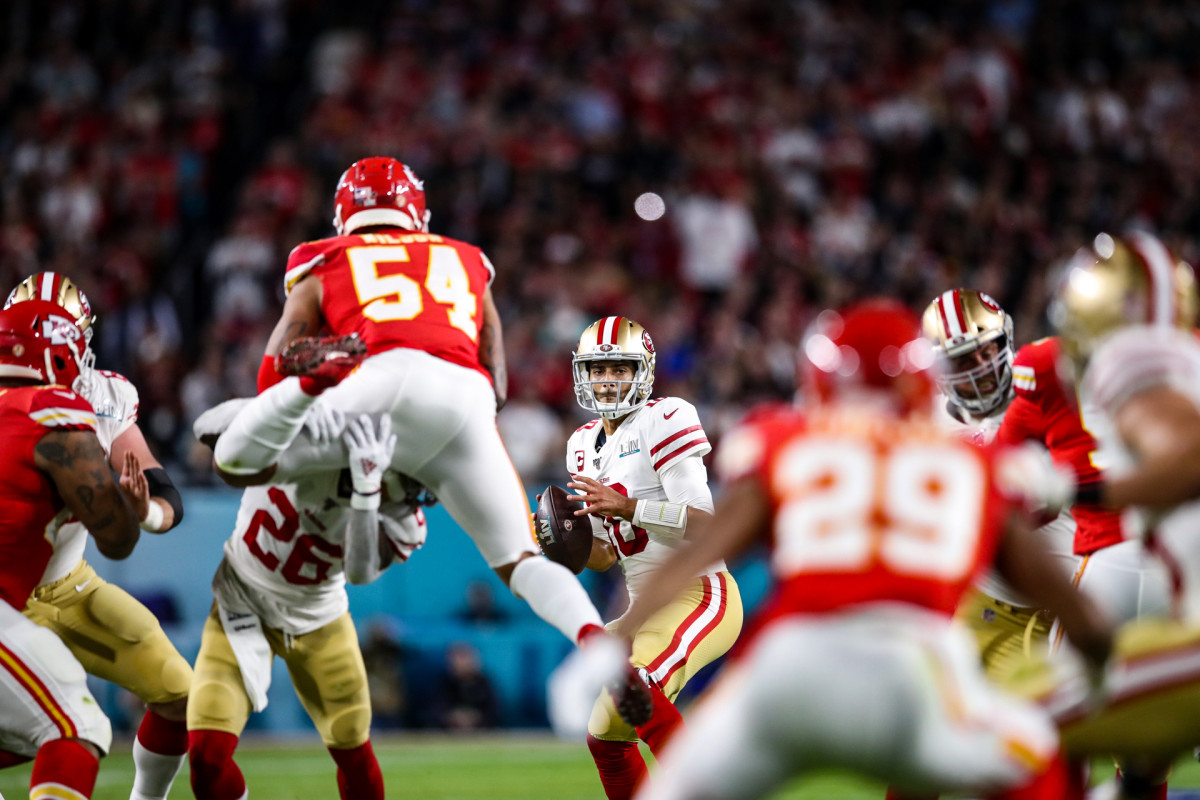
Jimmy Garoppolo.
Patrick Mahomes

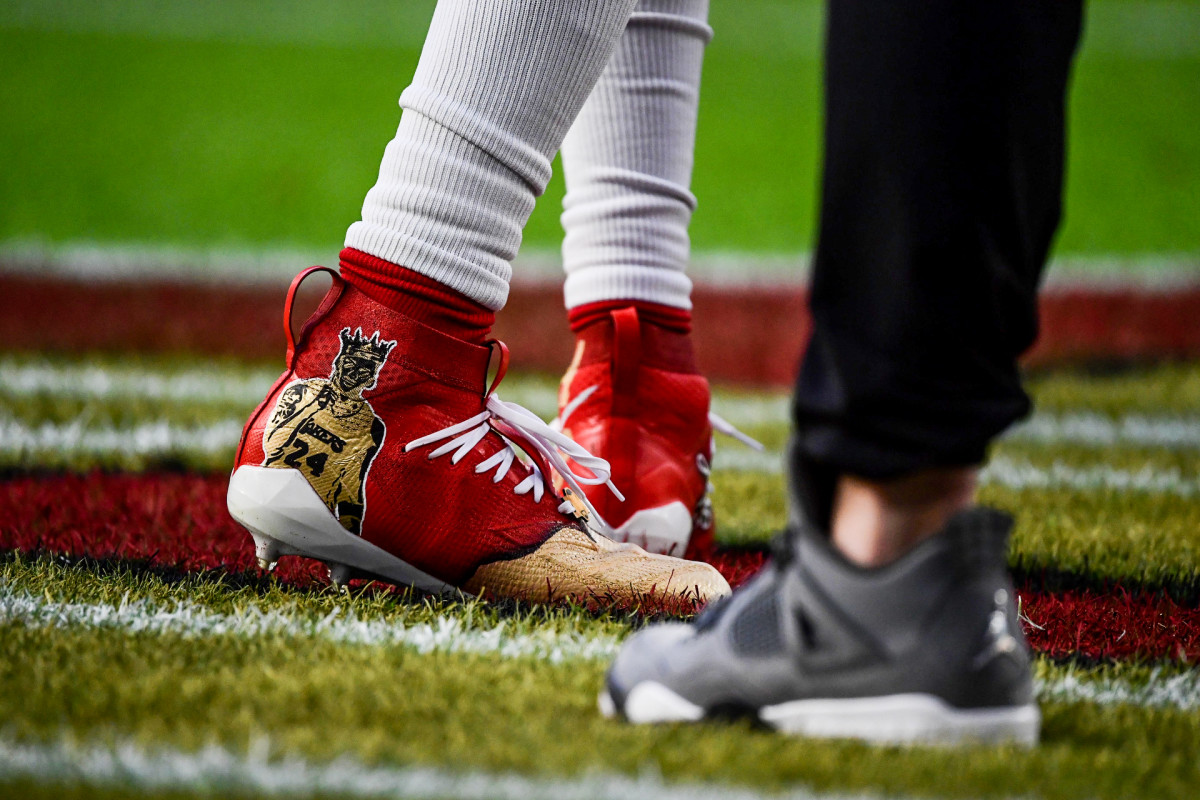
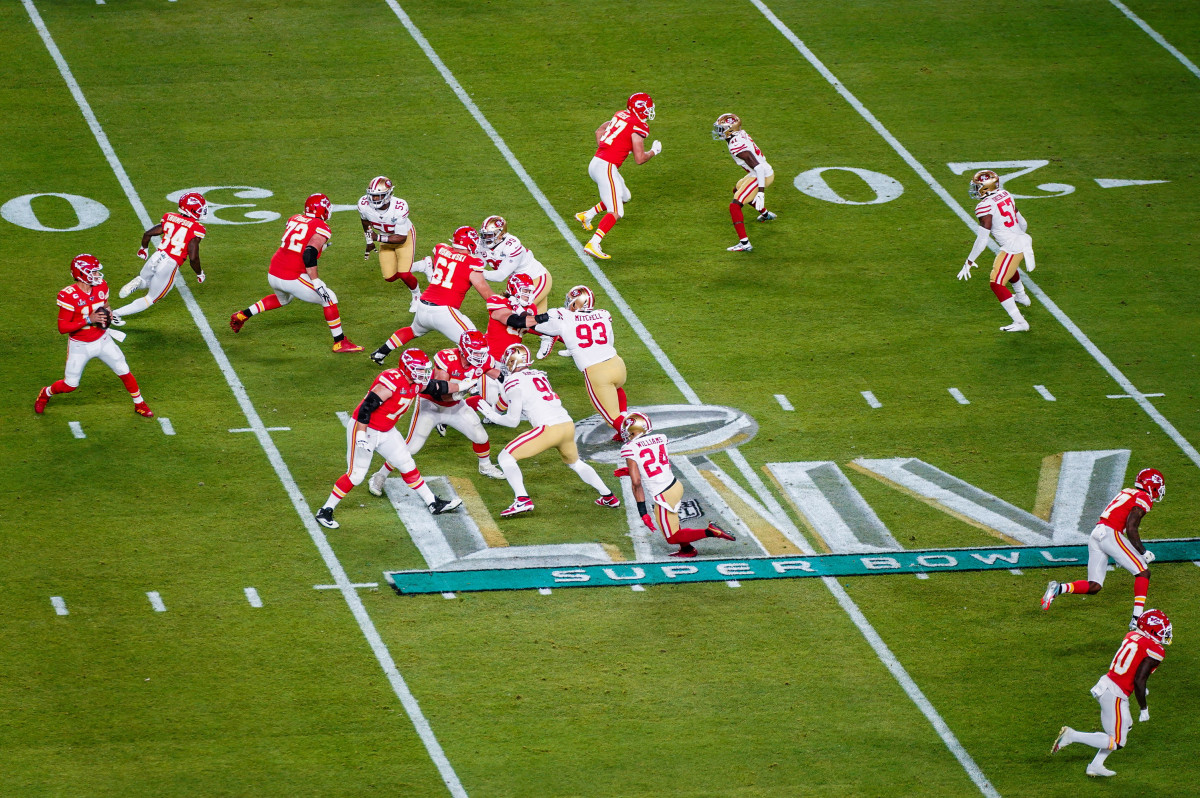
Mahomes wasn’t much more than a flashy stat line at that point, another product of the Air Raid. But his tape mesmerized Veach, who saw Mahomes carry the Red Raiders that season against an LSU team stocked with future pros, dizzying defenders all over the field. “Pat plays the game the way you would play with your brothers growing up in the street,” Veach told his colleagues. The next season, Veach drove to Ames, Ia., for a meaningless game played in freezing cold, with swirling winds. The stands were virtually empty when Tech fell way behind early and Mahomes aggravated a shoulder injury that sent him to the sideline. At halftime, Veach packed his bag and grabbed some food, planning to leave, only to see Mahomes return with a separated shoulder, for no reason other than to compete.
Veach started to send Reid clips of the quarterback he coveted, 10 at a time, until Reid could no longer tolerate the barrage. “You’re killing me,” he’d write back. “I’m trying to work here.”
Mahomes entered the draft after his junior season, and Kansas City traded up with Buffalo to pick him, sending a third-round pick that year and a first-rounder in 2018 to jump from No. 27 up to 10. The rookie sat behind veteran Alex Smith that season but continued to wow Veach in person, the GM rushing back to his office after training-camp practices to savor the third-team film he otherwise would have hardly watched. Reid, meanwhile, started to send giddy clips back the other direction, even sharing them with Hunt. “During that ’17 camp, before the MVP and the no-look passes, there was this moment in time where he had an interdepartmental cult,” says Veach.
The obstacle: Smith surpassed anyone’s expectations that season, throwing for 26 touchdowns and 4,000-plus yards. The Chiefs knew how little that mattered, though; as did Mahomes’s family and close friends. “He was going to sit a year, and then he was going to play,” says his father, Patrick Mahomes Sr. “I knew that was probably going to happen.”
The day after the Chiefs traded Smith to Washington, in January 2018, Mahomes and his father went to play golf. Patrick briefly expressed a low level of shock, then went back to crushing drives. He won league MVP that season and lost the AFC championship game to the Patriots, vowing afterward that he would return as soon as possible, and win it.
* * *
Patrick Mahomes saw the end of this season coming. Well, not all of it. Not the Titans’ swaggering into Gillette Stadium and upsetting the Patriots in the wild card round. Not Derrick Henry then running all over the Ravens, the top seed in the AFC. Not the clear path that opened to Kansas City’s first Super Bowl berth in 50 years—not the month the Chiefs upended decades of bad bounces, bad calls, bad plays and bad kicks, all connecting into a tapestry of misery. “Buzzard’s luck,” Lamar Hunt called it.
Mahomes met with Sports Illustrated in late December, and while he acknowledged then that Baltimore quarterback Lamar Jackson deserved to win the MVP award, he made two things as clear as the sky on Super Bowl Sunday in South Florida. First, he was a better quarterback this season than he was a year ago. And second, the Chiefs were better positioned to win the whole thing this time because of their revamped defense, their improving health and their late-season momentum.
The quarterback had taken a few weeks off after that playoff loss to New England last January—then he began a not-insignificant overhaul of his game. He sat down with his longtime trainer, Bobby Stroupe, to map out his offseason. “The goal was never anything statistically,” says Stroupe. “The goal was the Super Bowl. It’s all he cared about.”
First, the men needed to make an honest assessment of Mahomes’s first year as an NFL starter, and they couldn’t afford to be blinded by his gaudy statistics. They knew that by January he was carrying a few more pounds than usual, and that the extra weight had limited his mobility, leading to painful lower-body hits that left him with sore joints and further hampered his movement. They also acknowledged he liked to skip breakfast and tended to over-eat at dinner, which accounted for the extra pounds.
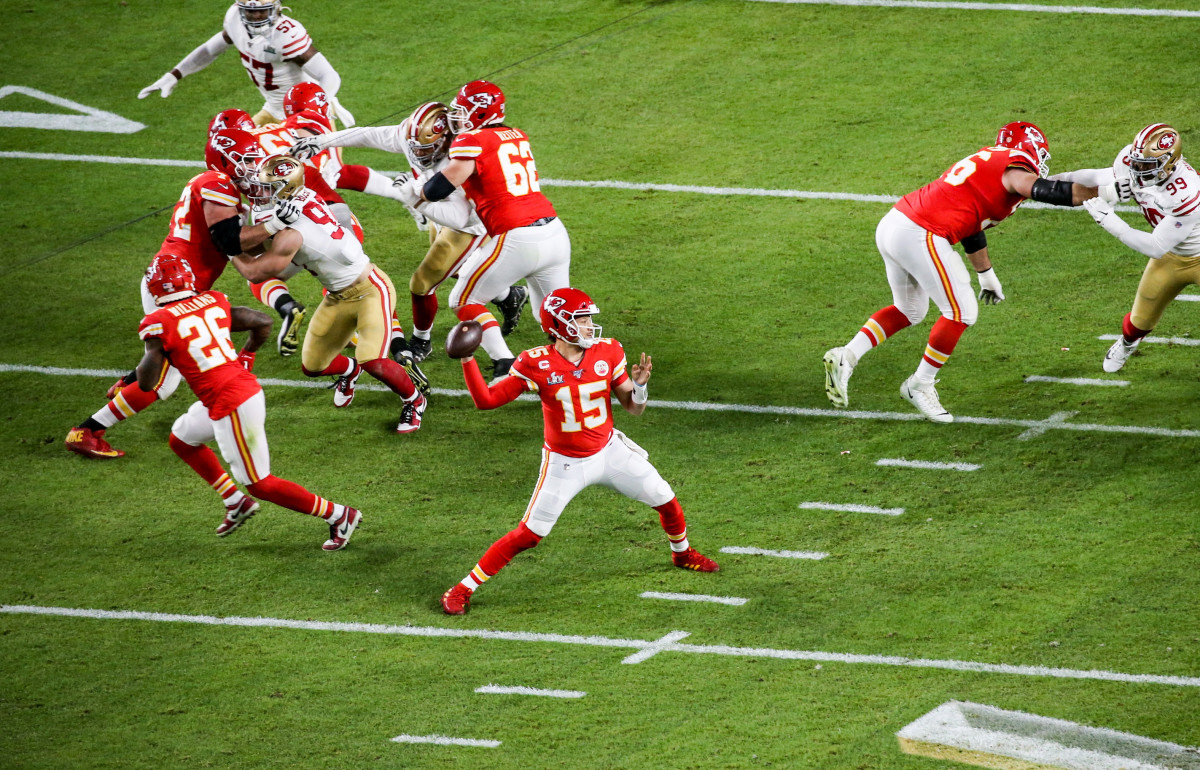
Mahomes wanted to enter this season at his athletic peak, with refined footwork and a lower weight. Hall of Famers Warren Moon and Jerry Rice both assess that Mahomes should rank atop any list of pure arm talent in NFL history. To that end, he didn’t touch his throwing motion last spring; he focused intently instead on his body’s lower half. Sure, he made dazzling throws with regularity—the no-look passes, the off-balance heaves, the across-the-body TD tosses—but he summoned that magic more often than he needed to. When he moved with the proper footwork he could “be as accurate as I want to be,” he says.
Mahomes summoned his private quarterbacks coach, Jeff Christensen, to Texas, along with Jeff’s son, Jake, and there they settled on two main goals: controlling Mahomes’s natural power through more efficient movement, and putting his body into positions that would allow him to throw without tension. “He has unlimited arm strength and can throw the ball out of the stadium,” Jake says. “[But] it’s his ability to throw guys open and operate as a passer rather than a thrower that really puts his greatness on display.”
They focused first on his head movement. If Mahomes exhibited any real flaw it was that his head tended to shift too far forward as he threw, forcing him to rely more on his throwing arm. And when that happened he tended to drive passes downward, locking his front leg. The Christensens showed Mahomes this bad habit on film, then drove to a nearby field. Mahomes warmed up for 15 minutes. Then he started throwing. “I don’t think his head moved forward the entire session,” Jake says. “It was one of the better displays of throwing a football we’ve ever witnessed.”
At Stroupe’s training center in Fort Worth, he also paced the QB through drills that forced him into awkward positions—skipping on one leg and walking on the other, jumping on one leg while in the middle of walking, landing and throwing to a location on the field whenever a clap sounds, all of it unorthodox.
Later, during Super Bowl LIV, Stroupe drew a direct line from all those drills to the comeback Mahomes sparked as he scampered away from pressure on what seemed like every throw: “We knew this was going to be required.”
* * *
Mahomes 2.0 began the same way he’d finished his MVP campaign. In staggering sum: 378 yards and three touchdowns in Week 1 against the Jaguars; 443 yards and four scores in Week 2 at Oakland; 374 yards and three TDs the following week against Baltimore. The Chiefs shot to 4-0, scoring at least 28 points in each victory, and Mahomes credited the otherworldly start to the changes he had made. The comparisons only grew: He was Vick, Ben Roethlisberger, Tom Brady and Aaron Rodgers all rolled into one, with a turbo-charged right arm, an acrobat’s body control and the wiggle of a magician, underwater, freeing himself from steel chains. “He reminds me of Brett Favre,” Moon says, “except Patrick is a better decision-maker than Favre ever was.”
Quietly, though, Mahomes was maneuvering that first part of the season like a duck on a lake—serene atop the water, legs churning furiously underneath. He suffered an ankle injury in the second quarter of the opener, and that limited the mobility he’d fought so hard to bolster. He could no longer move in space to throw his wideouts open, and he couldn’t generate as much power from his lower body. That he played so well despite the injury spoke to his unending gifts, but the foundation he’d rebuilt began to crack: too much freelancing, drifting and heaving throws off his back foot, Moon says.
Then, more buzzard’s luck: a dislocated kneecap. There were the Chiefs, at Denver in Week 7, ahead 10-6 in the second quarter, when Mahomes attempted a quarterback sneak and didn’t rise immediately after the play. Chiefs fans might have thrown a remote or five right at their flat screens—and initially Mahomes shared their concerns. He looked down at his right leg and saw the kneecap had moved. “That was the first thing that went through my mind,” he says, “when I saw it sideways: That doesn’t look normal; that can’t be good.”
Veach watched the second half with his injured quarterback, their fears evaporating when team doctors shifted the kneecap back in place and Mahomes felt little pain. (He felt so good, in fact, that he had argued to go back in.) The next morning, at team headquarters, Veach saw his MVP running in the hydro pool. The QB fired off video clips to his trainers, of himself throwing, and the footage floored the Christensens again. “Get as many reps in as the medical staff will allow,” Jake instructed. “Because you look perfect.”
Mahomes didn’t play the next two weeks—backup Matt Moore filled in capably—but he also didn’t miss a single practice. Just parts of them. Forty-eight hours after the injury, he and Stroupe began to analyze his movement. The elder Christensen flew in on the team’s bye, in Week 12, to clean up any lingering footwork issues.
Mahomes had returned in Week 10, just 24 days after the kneecap debacle, and while Stroupe estimates the QB played that week against the Titans at 60% of full health, he still threw for 446 yards and three touchdowns, proving that what seems like hyperbole can sometimes actually be fact. The Chiefs won their final six games as Mahomes rounded back into MVP form, and Kansas City’s die-hards started to believe again. In three of those six victories, the Chiefs defense held opponents to nine points or fewer, and they never allowed more than 21.
In the span of just one football season, Mahomes had improved his play, destroyed defenses, racked his body, regressed with his fundamentals, made a full recovery and vaulted Kansas City back into the playoffs, despite a host of injuries to his teammates. “Last year was not a fluke by any means,” says Kelce. “He’s still the best quarterback in the NFL.”
And in the playoffs Mahomes proved it.
* * *
If Mahomes ascends to Tom Brady’s level of perennial excellence, becoming a Super Bowl staple and the face of the NFL, throwing for 100,000 yards and banking a billion dollars in contracts and endorsements, then the 2019 playoffs will define his career more than the MVP campaign. For the magic that he summoned and the comebacks that he willed. “I think all the other quarterbacks love watching him, too,” says Brady.
That started in the divisional round, against the Texans, who shot to a 24-0 lead in only 16 minutes. Teammates say Mahomes never panicked, though. He completed one pass, then another; he threw one touchdown, then another, then another; he exploited Houston’s failure to deploy adequate resources toward Kelce, who caught three touchdowns. The Chiefs scored 51 points behind five Mahomes TD throws, and those around him believe the injury helped him, forcing him to be a more precise passer in the pocket. Now he was just as deadly with short completions as he was with breathtaking bombs. He could deliver death by beheading and death by a thousand papercuts.
“The game changed,” says Usain Bolt, the fastest man in the world, who noticed the way Mahomes implored his teammates on the sideline in the comeback over Houston. “To me, that’s a true leader.”
That victory pushed the Chiefs back into the AFC title game, against the Titans. And there, one play cemented Mahomes’s burgeoning legend. They’re calling it The Run. It happened with 23 seconds left in the first half, with the Chiefs behind by a field goal. Mahomes took the snap in shotgun, quickly ascertained that his targets were all covered, and sensed an opening against a Titans front that was all bunched together. He sprinted toward the left sideline, pushed down his instinct to run out of bounds, skipped past a diving defender, then paused and shifted back up the left sideline, his momentum carrying him up field. He shifted back right, spun among three more defenders, and powered his way into the end zone’s yellow paint, leading his nervous offensive coordinator, Eric Bieniemy, to joke that he might force the QB to wear a neck roll.
The Chiefs had secured their first Super Bowl berth in 50 years, and right then it seemed like a new era of NFL football had dawned. The Mahomes Era, more or less, with a little Russell Wilson and Lamar Jackson and Deshaun Watson mixed in.
* * *
When the Chiefs descended upon Miami for Super Bowl LIV, family and friends in tow, they used every available resource at their disposal. Kelce rented a house across the street from the ocean for his personal chef (and friend since the fourth grade) who cooked the tight end local snapper, grass-fed filet and chicken skewers on the grill. It was only two years earlier that the All-Pro tight end’s family had gathered at U.S. Bank Stadium in Minneapolis, sitting near the end zone where the Philly Special became famous, watching Travis’s older brother, Jason, win it all with the Eagles. At the afterparty, the boys’ father, Ed, noticed Travis sitting by himself, an atypical moment of contemplation for his gregarious son, who stared at his table. Sure, Travis was happy for his brother. But he seemed to want to be just as happy for himself.
“I gotta believe he was thinking, Why aren't I here?” Ed says. Fast forward two years, to Miami, and the family found itself gathered on the Chiefs’ hotel patio in Aventura, when the two brothers broke off into conversation, Jason walking Travis through how to handle the game. “Don’t overthink it,” big brother told little brother. “You know what you do well.”
As the game drew closer, Reid summoned another source of advice for his team: He invited his first draft pick as a coach, former Eagles QB Donovan McNabb, to practice. McNabb and Reid had reached the Super Bowl together once, 15 years ago, but they fell to Brady’s Patriots, starting a narrative around Reid’s career as the guy who couldn’t win it all. As McNabb stood before the Chiefs, he emphasized his experience as it related to their opportunity.
“At the end of it all, this could be your last time here,” he remembers telling players. “Losing sucks. You have regrets, doubts. I've never been on a winning side, and I told them, ‘You guys should [win].’ ”
The Chiefs then went out and did the one thing McNabb and Reid never had. Kelce caught six passes for 43 yards, including the score that pushed his team back into the game. Kansas City scored 21 fourth-quarter points, tied for a Super Bowl record. And Mahomes became the game’s youngest MVP, afterward telling Veach, the man who’d found Reid his quarterback, “Thanks for putting all this together, man.”
“Thanks for making it work,” Veach told him. “You’re the best in the game.”
* * *
Before Reid interviewed for the job in Kansas City, he had in mind a few ownership groups that he hoped to someday to work for. And prominent on that short list were the Hunts. Their histories and their missions were already aligned.
Lamar Hunt founded not only the Chiefs (as the Dallas Texans, in 1960) but also the American Football League, which merged with the NFL in ’70. He’s credited with coming up with the term “Super Bowl,” and his family is woven into the fabric of NFL history as much the Maras are in New York, or the Rooneys in Pittsburgh, the McCaskeys in Chicago.
Lamar’s wife, Norma, attended the Chiefs’ first championship triumph, 50 years ago, and every Super Bowl before and since. Think about that. She went 49 times before Kansas City could hoist another trophy, and she did so with the same grace as her husband, a man who would apologize to his general managers for calling too late, who would fly in coach while his coaches enjoyed first-class seats. “I’m terribly biased,” says Carl Peterson, the Chiefs’ president and general manager from 1989 to 2008, “but I don’t think anyone contributed more to the success of professional football in the United States than Lamar Hunt.”
Before the AFC title game Clark Hunt walked the parking lots at Arrowhead Stadium, the same way his father used to, in the bitter cold. Hundreds of heated red-and-gold mini-tents spread for miles in every direction, and he thought back to his dad, the way Reid must think back to his son. Standing on the stage later that day, accepting the trophy named after his dad, for the AFC champions, he looked off into the stands. It seemed like every fan had stayed, in below-freezing temperatures. “My dad was always about the fans,” he says, and they returned the favor, whooping and dancing for their owner. For their quarterback. And for their coach.
* * *
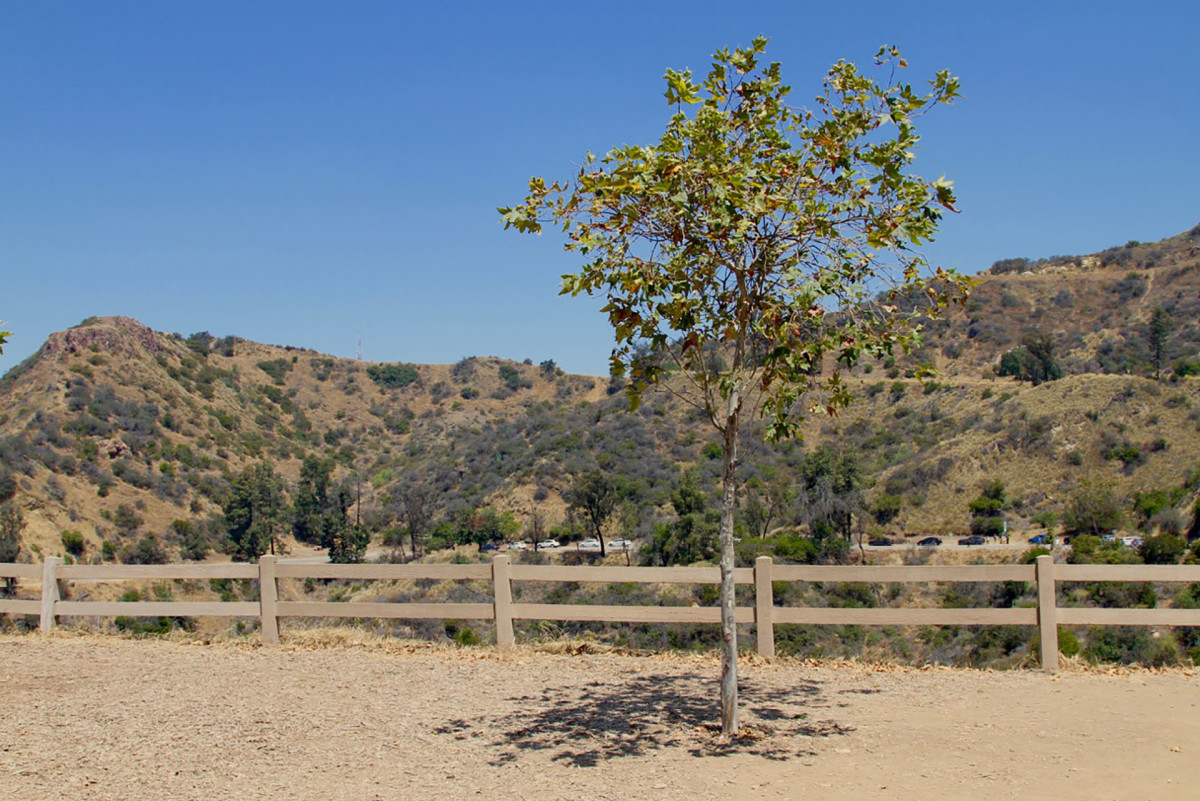
After Garrett Reid died, his father’s best friends from childhood decided they had to do something, and here they turned to Tony Stewart, who’d grown up with Andy in Los Feliz. Stewart was the mensch who kept the group together, who organized reunions, who helped freeze-dry and ship Reid his favorite cheeseburgers from the Original Tommy’s, near their old neighborhood.
Eventually the group settled on a tree. They would plant a sycamore at Griffith Park in Los Angeles, dedicated in Garrett’s memory, and as the years passed a group of 20 or so friends would stop by, watering the roots, clearing the weeds. That tree grew over 10 feet tall before Reid finally visited, in June 2018, with his wife, Tammy, and several of his friends. They told a few stories and shed more than a few tears, and then the whole group went back to the house of Mark LaBonge, a camera operator in Hollywood—the man who hosted Sunday’s Super Bowl party with the wooden urn and the gold-plated plaque—for lunch. In the middle of the post-feast hangout, Reid rose from the table and left the group behind, only to be found later in the kitchen, an NFL head coach washing dishes for his friends.
Fifteen months later, last Sept. 9, Tony Stewart died after suffering a stroke. And without the old mensch to steer the tribute, Reid's friends settled on another kind of dedication: Win the Super Bowl for Tony.
For years, critics defined Reid’s career by the one game he’d never won, as if that damaged his complete résumé or rendered his offensive innovations and his 222 career victories any less impactful. But Reid never saw his life like that.
No matter where he went—to BYU, to Green Bay as an NFL assistant, to Philly as a head coach and then to Kansas City—he always came back home. To his boys and to his burgers and to the center of their group, Tony, a man who loved pranks and lived stress-free, turning strangers into instant friends. “Andy just likes being 17 again,” his wife would tell LaBonge about what drew her husband back to L.A.
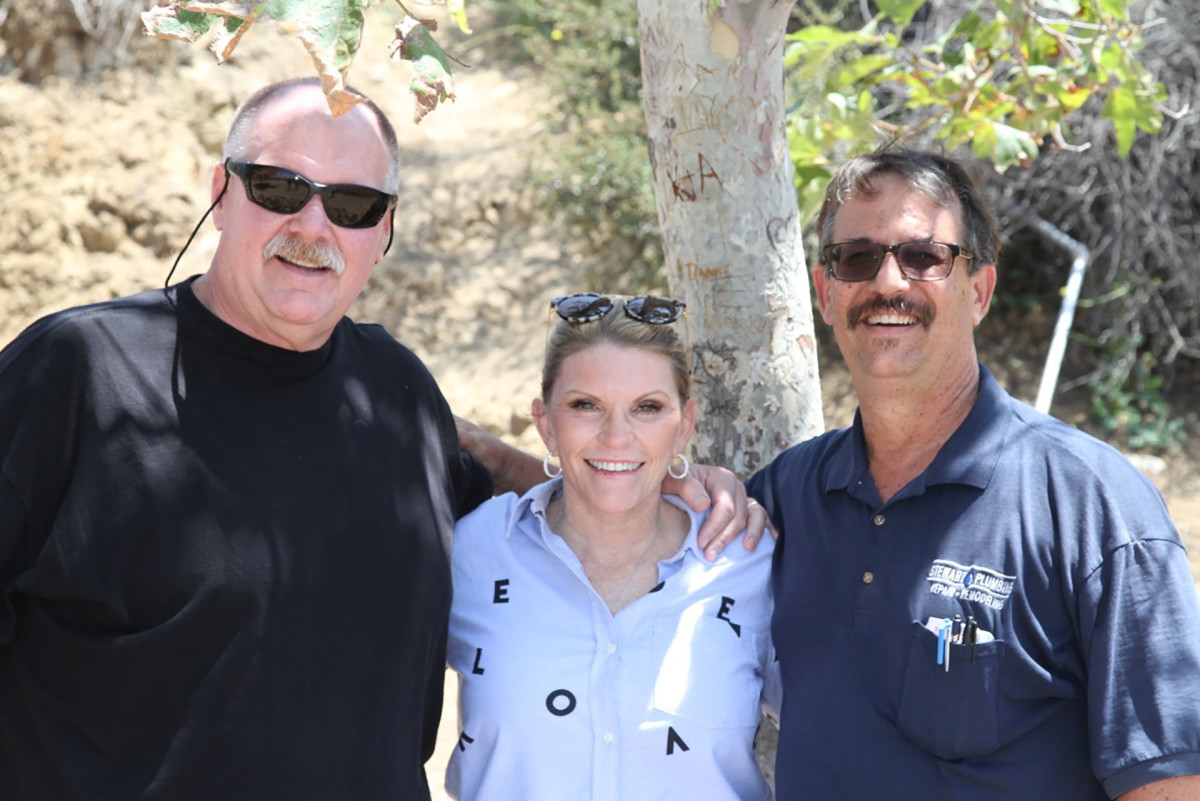
Last December, as the Chiefs closed in on a playoff berth, and after Tony’s death, memories continued percolating with the group. Another friend, Ted Pallas, went by Tony’s house, helping his widow, Monica, sort through some belongings—vintage baseball cards and the likes. On the mantle in the living room he spied a football, signed by Reid, that Tony had purchased at a charity event. Next to that were Tony’s ashes. Pallas took some of the remains, along with a Chiefs hat, and he shipped it all to Kansas City, where Reid texted back about the lump in his throat, detailing just how much his friend had meant to him.
“He was one of my guys,” Reid said as the Super Bowl drew near. “Ton of energy, great person, kind of the organizer. He’ll be there in spirit.”
Now Reid had even more driving him to win a Super Bowl, and it had nothing to do with his résumé or the Hall of Fame or any abstract notion argued about by talking heads on television. He needed to win for Tony, for Ted, for the boys he grew up with in Los Feliz who had long ago become old men. For Tammy, for Garrett and for his other four children. He needed to win for the Hunts, for Veach, for Kelce, for his coaches and his players. He needed to win for Mahomes. He didn’t need to win for himself.
When the Chiefs erased that deficit against the Titans, LaBonge says, “I gotta believe in my own crazy Irish-Catholic superstitions that (Tony) was up in heaven doing whatever he could to help.” His voice drops to a whisper. “I wish he was here,” he says. “he would both be screaming and yelling his heart out.” For Andy Reid, of course, the coach who won the one game the world thought he needed to, when so few knew what he really needed.
Additional reporting by Conor Orr, Albert Breer, Kalyn Kahler and Madelyn Burke
More SI Super Bowl LIV Coverage
* Michael Rosenberg: Patrick Mahomes Is Here To Stay
* Conor Orr: Shanahan Absorbs Gut-Punch Super Bowl Loss
* Kalyn Kahler: Reaction From the Niners' Stunned Locker Room
* Charlotte Wilder: Super Bowl LIV Was One Giant Spectacle
More From SI.com Team Sites:
* Niners Fall Agonizingly Short In Super Bowl
* Kittle Reflects on Turning Point of Niners' Loss
